






Managing Editor Consultant Editors
Sarath
Art & Design
Charlie
Louis
Branding & Marketing Partnership
Jennifer
Monica
Rachel
Free Subscription www.cxomagazine.com
International Partnerships admin@cxoomagazine.com Americas
Follow Us On www.linkedin.com/company/cxomagazinepage www.facebook.com/CXOMagazinePage



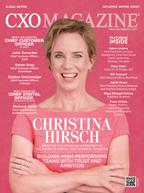

Not long ago, a senior executive shared something that stuck with me.
“Some days,” she said, “I feel like I’m leading a team, managing a tech lab, navigating global trends, and being a therapist—all before lunch.”
We both laughed, but the truth behind her words was undeniable. Today’s CXO wears many hats—and the wardrobe keeps growing.
We’re living through one of the biggest shifts in business history. AI and automation aren’t just changing how we work—they’re changing how we lead. It’s no longer enough to hit targets or streamline operations. Today’s leaders are being called to do more: build trust in machines, nurture human potential, and steer companies through uncharted, fast-changing terrain. That sounds like a lot, doesn’t it? Because it is.
But here’s the good news—where there’s complexity, there’s also incredible opportunity. The most effective leaders today aren’t just tech-savvy. They’re humancentric. They don’t see AI as a threat, but as a partner. They blend logic with empathy. Data with instinct. Strategy with storytelling.
This issue of CXO Magazine is a deep dive into that evolving role. Inside, you’ll find perspectives from executives who are not just surviving this transformation—but shaping it. From thought-provoking Op-Eds to real-world leadership journeys, we’ve curated insights that are as practical as they are inspiring.
Our cover story spotlights Christina Hirsch, Executive Vice President and President of the Board of Digital Trust Business at Swisscom. Christina’s story is one of bold reinvention—of leading through complexity with clarity, and always putting people at the center. Whether she’s managing post-merger integrations or scaling digital trust across Europe, she does it with purpose and precision.
So as you flip through these pages, we invite you to pause, reflect, and maybe even smile at the paradoxes of modern leadership. How do you stay grounded when the ground keeps shifting? How do you lead teams that include both humans and algorithms? We don’t have all the answers. But we do have stories worth reading.
Enjoy the issue.

Sarath Shyam
EXECUTIVE VICE PRESIDENT & PRESIDENT OF THE BOARD OF DIGITAL TRUST BUSINESS, SWISSCOM
BUILDING HIGH-PERFORMING TEAMS WITH TRUST AND AMBITION


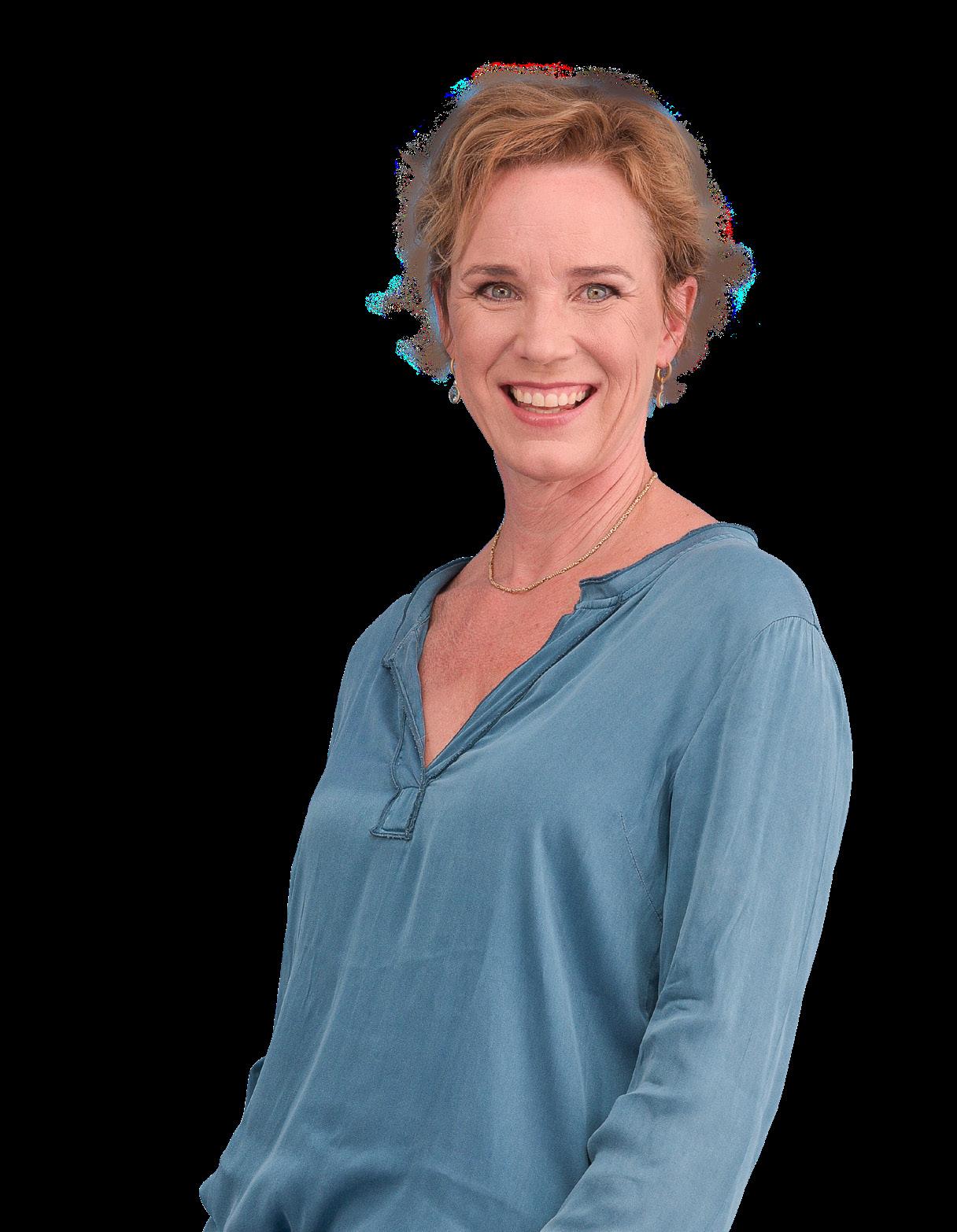
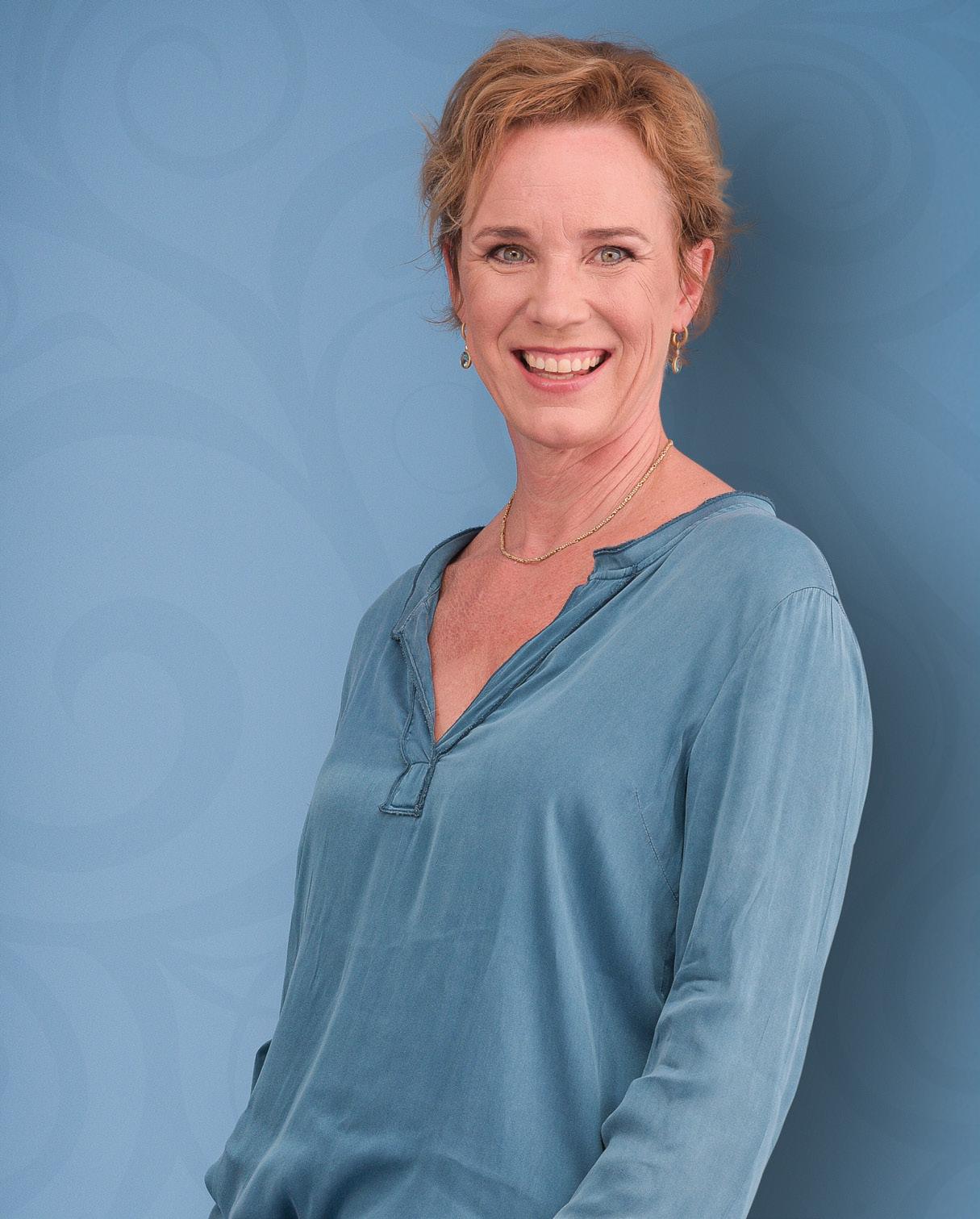

24
John Durocher, Chief Customer Officer, Calix
Empowering Communities Through Experience Driven Broadband Transformation

46 Karen Gray, Chief Customer Officer, Centerbase
Shaping the Future of Customer Success Through Empathy, Data and Clear Leadership
80
Sophie Steinmeijer, Chief Customer Officer, TOPdesk
Driving Scalable Customer Success Through Empowerment, Collaboration and Continuous Innovation
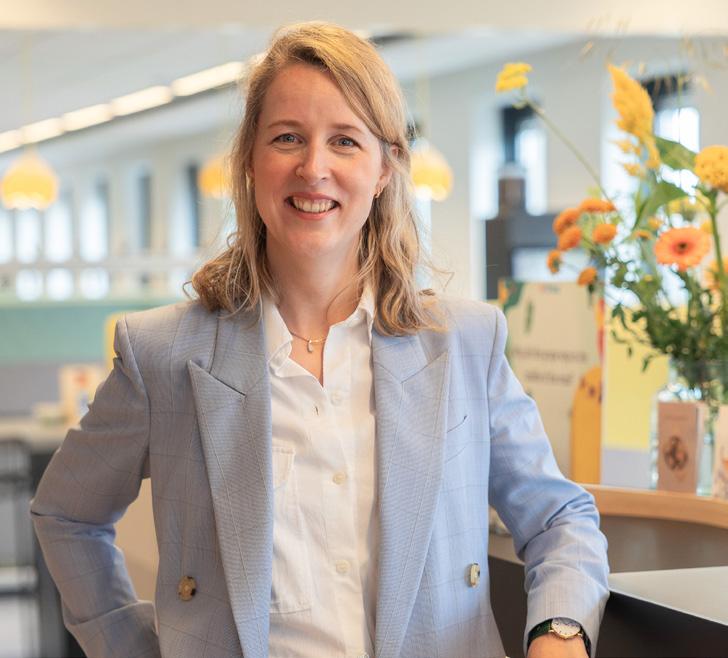
CHIEF DIGITAL OFFICER
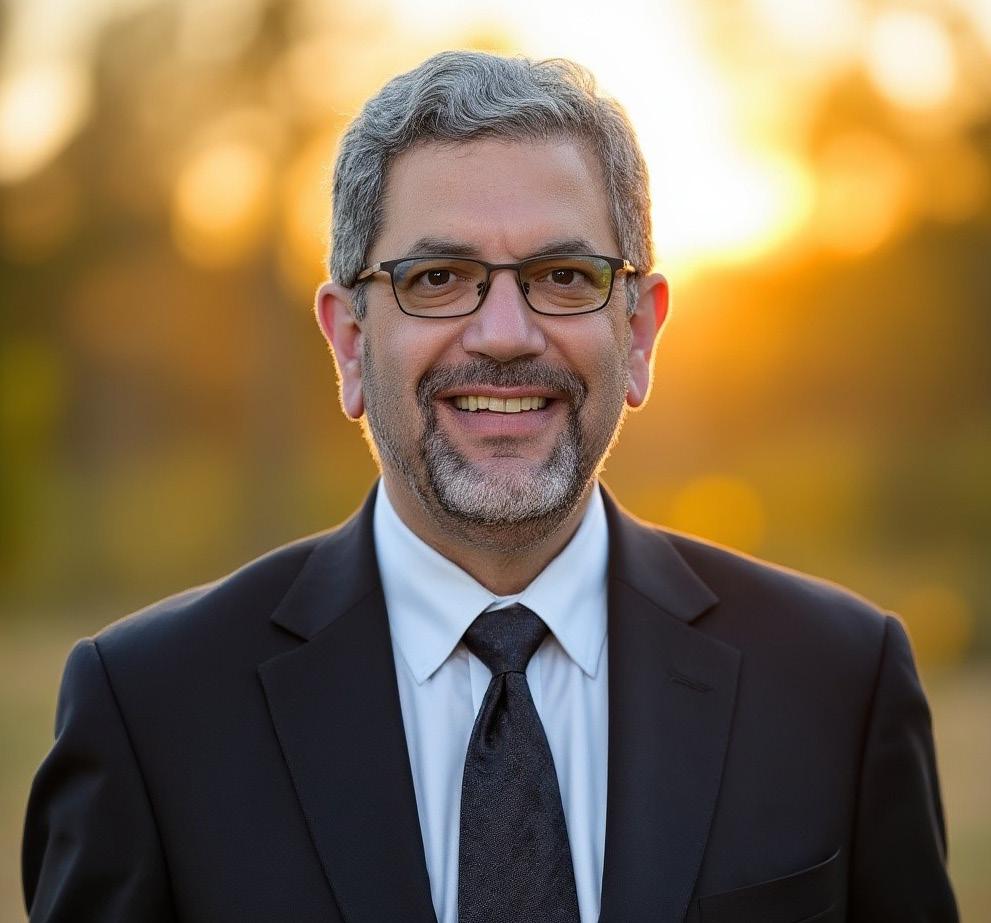
62
Richard Jacik, Chief Digital Officer, Brillient Corporation
Leading Digital Transformation with Architecture Innovation and Human-Centered Automation
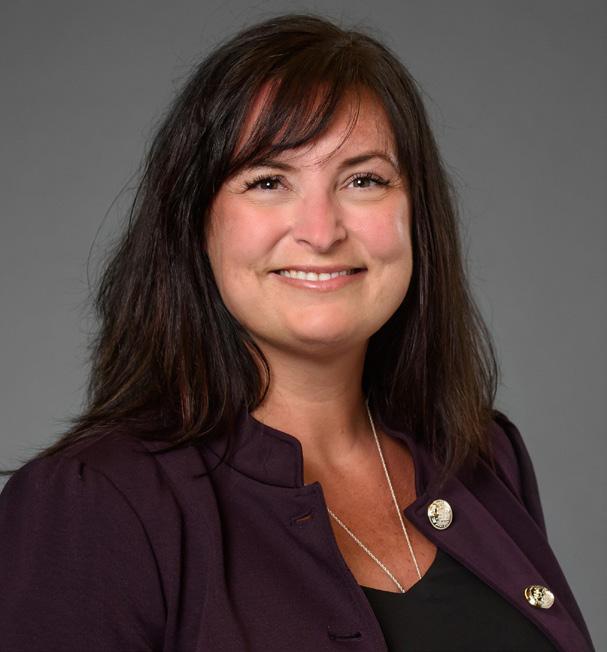
16 Judith Breen, Vice President Partner Alliances and Portfolio Solutions, Insight Making an Impact through Strategic Partnerships
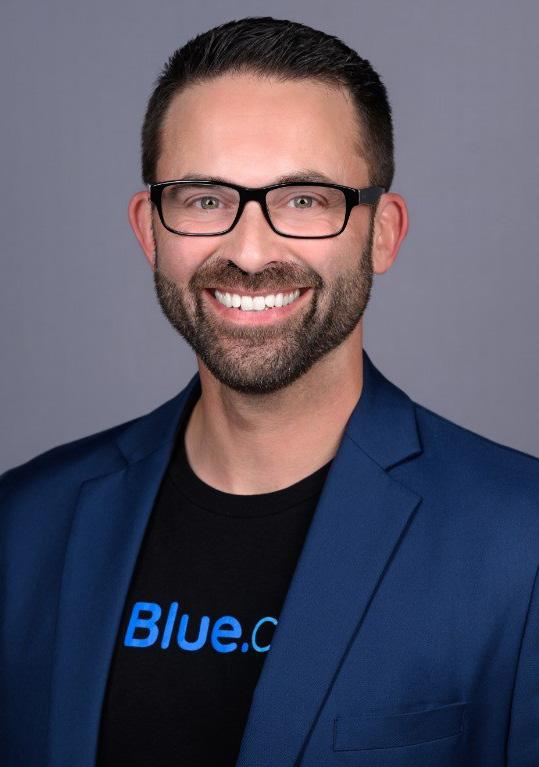
34 Bill Tennant, Chief Revenue Officer, BlueCloud
Scaling AI with Speed and Trust: The Blueprint for Future-Ready Enterprises
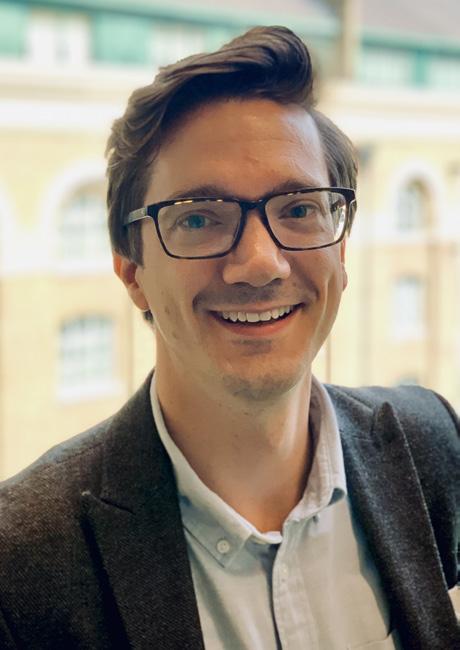
40
Peter Aitken, Senior Director, Head of Customer Strategy and Insights, Kantar Driving Business Growth through CX Innovation
54
Mary Michael Sellers President, Scantron
Reimagining Data Intelligencethrough Human-Centered Innovation and Ethical AI


74
Adam Lindsey, VP, Groupon Operations | Cross-functional Team Leadership, Strategy, Groupon
Driving Meaningful Change through Customer Insights

94
Banu Cinar, Head of CX Design, JLR
Paving the Way for Customer-Centric Innovation

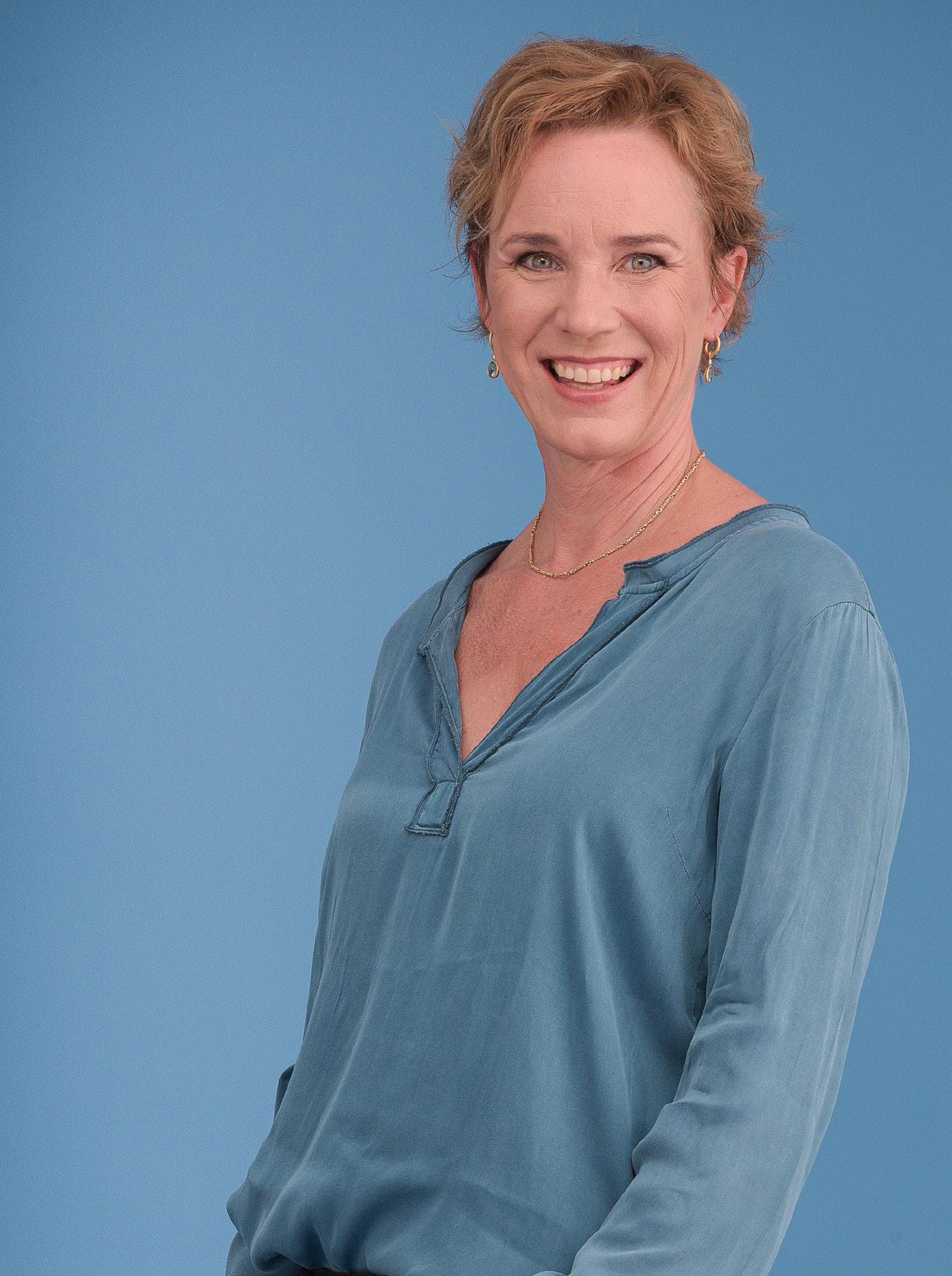



EXECUTIVE VICE PRESIDENT & PRESIDENT OF THE BOARD OF DIGITAL TRUST BUSINESS,
Christina Hirsh has 25 years management experience including for Swisscom, Vodafone and Sony. She has excelled in operational and strategic areas including digital transformation, reorganization and cultural change, post-merger integration as well as sales and marketing covering B2B and B2C businesses. Today she is responsible to grow 'Digital Trust' as business division within Swisscom on a European scale and a focus on organic and inorganic growth. Her passion is for people, performance and trust.
Recently, in an exclusive interview with CXO Magazine, Christina shared insights on the role of technology in driving business growth and innovation, her secret to striking a work-life balance, favorite quote, future plans, words of wisdom, and much more. The following excerpts are taken from the interview.




Hi Christina. What drives your passion for people, performance, and trust in your leadership role?
I would put it the other way round, my passion for people, performance and trust drive me in my leadership role. I am convinced that performance is a result of a motivated team with a great passion for the targets and the tasks. Trust is crucial for three reasons: Without the trust in a positive result, we are passive and not brave. Without the trust in the team, open sharing of opinions and fights for the best solutions will not happen. Without the trust in leadership people are more busy playing 'not to lose' instead of pushing the business ahead. So, for me the combination of the three is like a natural upwards spiral the entire team I am trying to ride.
What role do you think technology plays in driving business growth and innovation?
Technology is an important part. If we look how much the existence of industrialisation, mobility and mobile internet has changed our way of life, it is mind-blowing. Nevertheless, technology is only accepted by users if they trust in the benefits. It must be reliable, work easily, be convenient, experience must be good, and the price may not be a burden.
So if I look at success of innovation, technology is often the starting point, business success relies on utilisation and positive acceptance. Failed innovations, happen mostly related to timing, costs and user acceptance and not so much because of the technology itself.

Customer experience teams are typically loaded by very smart and ambitious ladies who love to take different perspectives and walk in the shoes of the customers

How do you stay current with the latest developments in digital trust and cybersecurity, and what sources do you rely on for information?
That is a tough one. I am super curious and love playing around with things that I don't know about. At the same time, I lose patience easily and must force me to try things again once the experience was bad. So as soon as I can test something, I get excited and start to imagine how to make a product out of it and sell it. Besides that, I enjoy talking to people, learning about their views, opinions and expertise as well as reading newsletters and visiting conferences.
Do you notice a lack of women in your industry? If so, why do you think that’s the case?
I would rather consider departments than the industry. Technology and IT suffer from a lack of women the most. I was part of tech-teams and always felt very welcome. It would be hard to count the number of tech-men I met, sharing their expertise and opening doors for me to grow and be part of the team. So, I don't think the problem is that women are not welcome in the tech industry. They tend to choose other areas, and it already starts in universities and with the education.
Vice-versa, customer experience teams are typically loaded by very smart and ambitious ladies who love to take different perspectives and walk in the shoes of the customers. If I were CEO of a tech company, I would bring the customer experience teams very close to the tech teams. It would improve diversity in both teams leading to better results and a joint broad mindset.
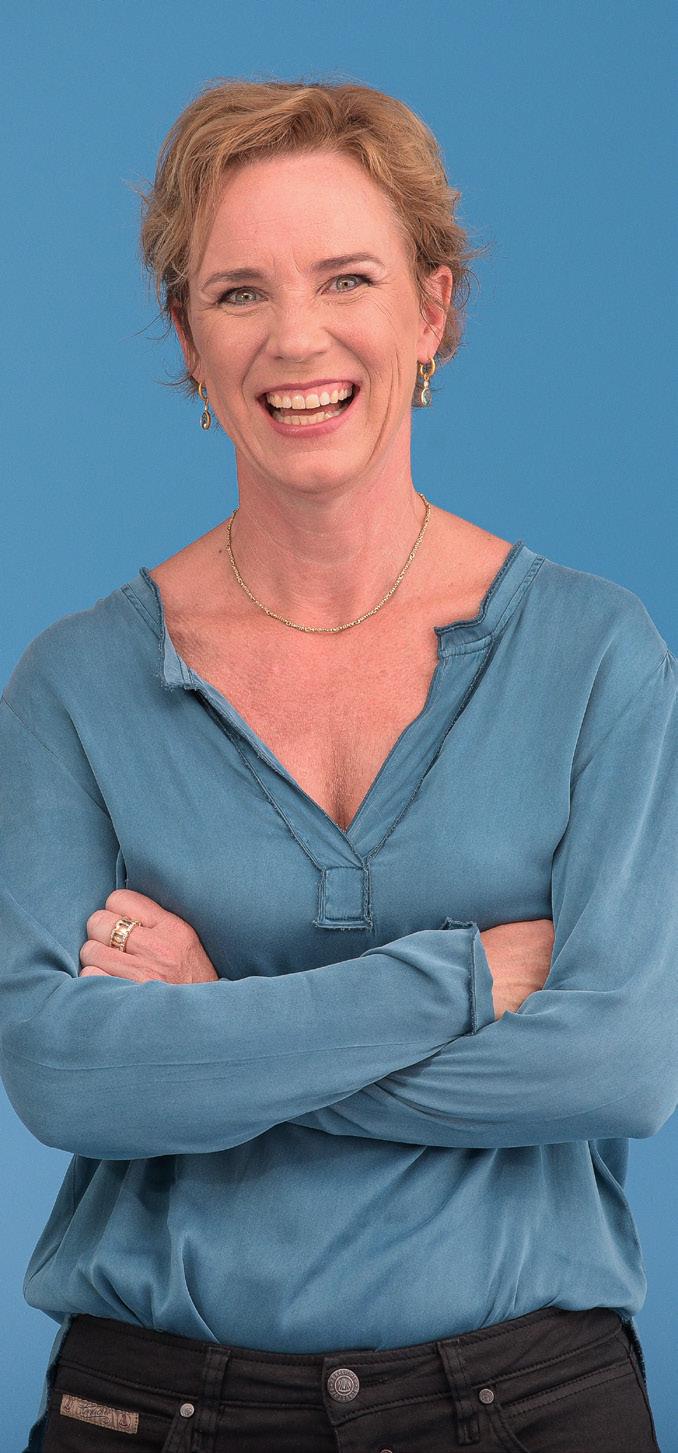
Work hard, build on your talents and passion and don't take it too seriously. Especially for the ladies: Don't be too shy to share your ambitions
Looking back, which women in your life have had the most influence on your career?
Clearly my mother. She encouraged my two sisters and me to be brave, independent, try things out, use our own brains and take responsibility. She also pushed me to work hard in school and considered education the key door opener in life, she chose a math-science focused school for me because she knew I would not be a good Latinstudent. She taught me to be active and practical. 'Pull yourself together' and 'you can achieve anything if you try hard enough' were sentences I heard often. We also had barbies; but I played with Lego Technik a lot.
What is your secret behind striking a work-life balance?
First of all, the attitude. I consider my work as 'daytime entertainment', so it does not feel like a heavy weight, or very seldom. I always choose work for myself that is interesting, fun and would allow me to grow. Love it, change it or leave it and I usually do love and change at the same time since I never had a responsibility without driving transformation. I also left responsibilities which were not suitable, and I always made sure to leave a positive last impression when moving on.
I enjoy a close circle of friends and family I love spending my time with. I also have great support from the best husband ever. He runs his own company; we are both quite busy and enjoy the time we have together. He even moved along to Switzerland with me, supporting my career and learning to speak French.
Last but not least, I go running every morning, look for a smart mix of healthy nutrition and have fun extensive dinners with friends and
family. I enjoy being on the water on the 'Lac Léman ', scuba diving, skiing, and I love the quiet moments with a book or some music. Music is very important to me, especially when running in the morning. It helps me to be creative and clears my head.
What is your favorite quote?
I stole this from Diane von Fürstenberg, and she got it from her mother: 'Fear is not an option'. I wear her dresses a lot, they were invented to be comfortable and female at the same point in time. I never liked wearing suits, it is either Jeans or dresses for me.
Where do you see yourself in 5 years from now?
Clearly, I’ll be having fun and enjoying great daytime entertainment. Business goals are super ambitious, so I see my team and me succeeding and growing together. I live in the French part of Switzerland, and I hope to minimise my accent and be very close to becoming bilingual in 5 years.
What advice would you give to aspiring leaders looking to grow their careers in technology and innovation?
Work hard, build on your talents and passion and don't take it too seriously. Especially for the ladies: Don't be too shy to share your ambitions. Even Santa Claus has difficulties finding the right present, don't expect others to read your mind. Sometimes, things don't turn out like we wish in life. Being 48 now, I learned that complicated situations are an excellent starting point to accelerate growth and if a chance is missed, something better comes along later. The key is to keep growing and learning.
Judith Breen is a visionary leader who has recently been promoted to Vice President, Partner Alliances and Portfolio Solutions at Insight Canada. With over 29 years of experience in the technology industry, Judith has been instrumental in driving the success of Insight Canada over the past 7 years. Her strategic vision and leadership have significantly contributed to the company's growth and achievements.
Before joining Insight, Judith spent 14 years at Hewlett Packard Enterprise, excelling in roles across sales strategy, sales, international business, and sales operations. Her academic journey includes studies in business and psychology at Concordia University and the University of Quebec in Montreal, and because she believes in always learning, she recently completed a mini-MBA at McGill University.
Judith is deeply passionate about mentoring individuals and building high-performing teams. She believes in leading from the front, embracing diversity of thought as a cornerstone of success, and upholding the highest standards of conduct in all endeavors. Her dedication to her teammates and commitment to their growth and development are key aspects of her leadership style.
Recently, in an exclusive interview with CXO Magazine, Judith shared insights on the role of diversity, equity, and inclusion in the tech industry, her secret to striking a work-life balance, favorite quote, future plans, words of wisdom, and much more. The following excerpts are taken from the interview.
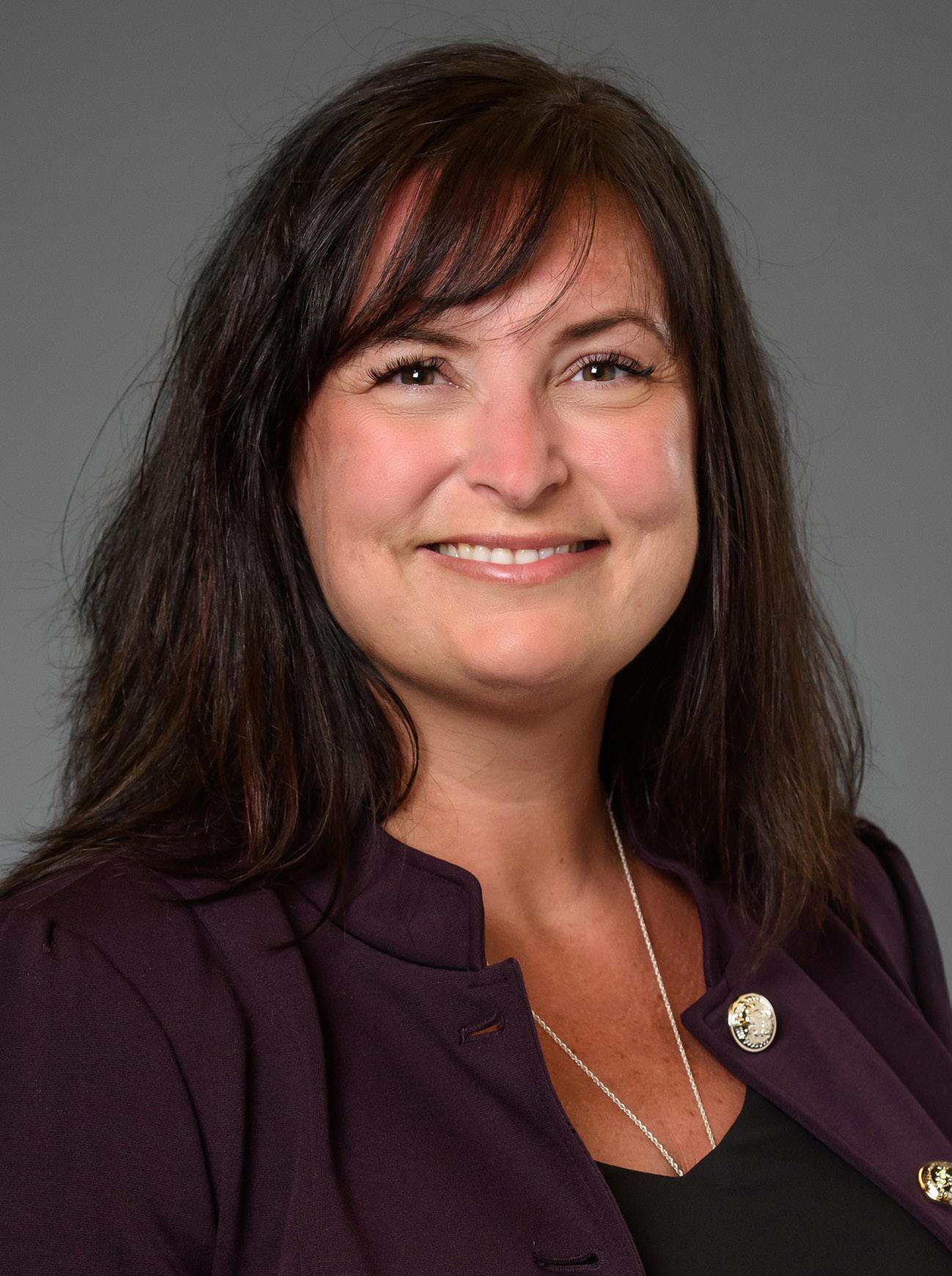
Judith Breen
Vice President Partner Alliances and Portfolio Solutions, Insight
Hi Judith. What inspired you to pursue a career in technology, and what were some early challenges you faced?
I was drawn to technology because it’s everchanging, dynamic, and challenging. That constant evolution excites me—there’s always something new to learn, a new problem to solve, and a new way to make a difference. I’ve always thrived in environments that push me to grow, and tech offered exactly that.
Coming into this industry, English wasn’t my first language. That added a layer of complexity early in my career—especially in high-stakes conversations or fast-paced meetings where clarity and confidence were critical. But over time, I turned that challenge into a strength. It taught me to listen deeply, to communicate with intention, and to lead with purpose. And after almost 30 years in the industry, I’ve built a career— and a voice—that reflects both resilience and adaptability.
Of course, the journey hasn’t always been easy. I’ve often found myself navigating spaces where I was one of the few women in the room. That came with its own pressures— feeling like I had to prove myself, balancing visibility with authenticity, and managing the mental toll of being constantly “on.” I struggled with sleep, with boundaries, and with the weight of expectations. Those experiences shaped how I lead today.
What do you love the most about your current role?
What I love most about my current role is the opportunity to lead with purpose and impact— every single day. As VP of Partner Alliances and Portfolio Solutions, I get to sit at the intersection
of strategy, innovation, and people. That’s a space I thrive in.
I’m energized by the challenge of aligning our partner ecosystem with the evolving needs of our clients. I love that no two days are the same. The pace is fast, the stakes are high, and the potential for impact is enormous.
But what truly fuels me is the people. I take immense pride in building high-performance teams and mentoring others to grow into their potential. Over the past year alone, I’ve helped five mentees and teammates step into new roles—and that’s the kind of impact I am proud to make. I believe in leading from the front, in creating space for others to shine, and in fostering a culture where people feel seen, supported, and empowered to contribute.
I also love that my role allows me to be a voice for change. As a woman in tech—and a mother—I care deeply about representation and equity. I speak on panels, mentor emerging leaders, and advocate for inclusive hiring practices not just because it’s the right thing to do, but because it’s essential for the future of our industry.
At the end of the day, what I value most is that I get to bring my full self to this role—my strategic mindset, my passion for people, my commitment to excellence—and use it all to help shape the future of Insight Canada and the broader tech ecosystem.
How do you see the tech industry evolving, and what opportunities or challenges do you foresee?
The tech industry is evolving at a pace we’ve never seen before—and it is said that the next 10 years will bring more change than the last 100. That’s not just a bold statement—it’s a reality I
see every day in my work with partners, clients, and teams across Canada and beyond.
What excites me most is the convergence of technologies like AI, cybersecurity, multicloud, and modern infrastructure. These aren’t just buzzwords—they’re reshaping how organizations operate, compete, and grow. I see massive opportunity in helping clients modernize their environments while optimizing for cost, performance, and resilience. Whether it’s enabling secure collaboration, scaling infrastructure, or unlocking insights through data, the potential for impact is enormous.
Another challenge is the human side of change. As someone who worked in Ontario for over 15 years—and who entered this industry with English as a second language—I know firsthand how important it is to create inclusive, supportive environments. The future of tech must be diverse, equitable, and human-centered. That’s why I’m passionate about mentoring, about supporting organizations like Technovation Montréal, and about using every platform I have to elevate underrepresented voices.
In short, I see the tech industry becoming more integrated, more intelligent, and more
But with that opportunity comes complexity. One of the biggest challenges I see is the growing gap between innovation and adoption. Many organizations are eager to embrace AI or cloudnative architectures, but they’re still grappling with legacy systems, technical debt, and talent shortages. That’s where trusted partnerships matter most. Our role isn’t just to sell solutions— it’s to guide transformation, build confidence, and deliver outcomes that matter.
Leadership isn’t about titles—it’s about impact. Success comes from fostering trust, creating space for others to grow, and leading with integrity, curiosity, and purpose
The next 10 years will bring more change than the last 100. The convergence of AI, cybersecurity, and cloud is reshaping how businesses operate, compete, and grow
people-driven. And I see our greatest opportunity in helping clients—and our own teams—navigate that evolution with clarity, courage, and purpose.
What's your perspective on the role of diversity, equity, and inclusion in the tech industry?
Diversity, equity, and inclusion aren’t just buzzwords to me—they’re foundational to how I lead and how I believe the tech industry must evolve. I know firsthand how important it is to create spaces where people feel seen, heard, and valued.
What I’ve learned is that diversity fuels innovation. When we bring together people with different backgrounds, perspectives, and lived experiences, we unlock better ideas, stronger teams, and more resilient solutions. But inclusion doesn’t happen by accident—it takes intention, accountability, and leadership.
That’s why I’ve made DEI a core part of my leadership philosophy. I mentor emerging leaders, support organizations like Technovation, and actively participate in initiatives that elevate underrepresented voices in tech. I’ve also contributed to campaigns like the DEI selfie video series, where I shared my own reflections on inclusion and belonging.
I believe the tech industry has a responsibility to lead by example. That means addressing systemic barriers, closing equity gaps, and ensuring that everyone—regardless of gender, race, language, or background—has a fair shot at success. It also means being transparent, listening deeply, and continuously learning.
At Insight, I’m proud to be part of a culture that values inclusive leadership. Whether it’s through speaking engagements, internal programs, or simply how we show up for one another, I see DEI not as a side initiative, but as a strategic imperative.
Because when we build inclusive teams, we build better businesses—and a better future for tech.
How do you approach leadership and what qualities do you think are most important?
I approach leadership as a responsibility to serve, inspire, and elevate others. For me, it’s not about titles—it’s about impact. I lead with intention, and I believe that how we show up matters just as much as what we deliver.
My leadership philosophy is grounded in four core values: passion, integrity, accountability, and open communication. Passion is the fuel. I believe that all great achievements start with a deep sense of purpose. I expect a bias toward action, and I celebrate success as a team. Integrity means walking the talk—leading by example, staying engaged, and living our values even when no one’s watching. Accountability is about setting high standards, being fair, and learning from mistakes. And open communication? That’s non-negotiable. Feedback is a gift. I give it, I welcome it, and I believe it’s how we all get better.
I also believe in leading from the front. I don’t ask anything of my team that I wouldn’t do myself. I’m a big believer in creating clarity as a leadership tool—it helps connect strategy to purpose and makes the work feel real. I strive to create a space where people feel safe to speak up, take risks, and grow. That’s how you build highperforming teams.
What I value most in leadership is authenticity. I’ve learned that the most effective leaders are the ones who are true to themselves. I bring my whole self to work—my experience, my perspective, my voice—and I encourage others to do the same. That’s how we build trust. That’s how we build culture.
And finally, I believe leadership is a journey. I’m constantly learning—through feedback, through mentorship, and through the people I have the privilege to lead. I don’t have all the answers, but I’m always listening, always evolving, and always striving to be better.
Looking back, which women in your life have had the most influence on your career?
Looking back, I’ve been incredibly fortunate to be surrounded by strong, inspiring women who’ve shaped my career in meaningful ways.
First and foremost, I think of the women in my family. Growing up, I was surrounded by resilience, resourcefulness, and quiet strength. They taught me the value of hard work, humility, and showing up for others—lessons that have stayed with me throughout my career.
Professionally, I’ve had the privilege of working alongside and learning from remarkable women leaders. One of the most influential has been Reem Gedeon, who not only challenged me to grow but also supported me unconditionally. When she joined Insight Canada to lead the business, she described me as a “pillar of support” and someone she could rely on to help navigate the organization. That trust meant everything to me—and it pushed me to lead with even more purpose and conviction.
I’ve also drawn inspiration from the broader community of women in tech. Through programs like Women of the Channel, the Microsoft Women partner council, The WIT Network and Women We Admire, I’ve connected with trailblazers who are redefining what leadership looks like. Their stories remind me that representation matters—that when we see women leading with courage and authenticity, we believe it’s possible for ourselves too.
These women—whether family, mentors, or peers—have helped shape not just my career, but my leadership philosophy. They’ve shown me that success isn’t just about what you achieve, but how you lift others along the way.
What is your favorite quote?
“All great achievements start with passion.”
What is your secret behind striking a work-life balance?
My secret to work-life balance? It’s something I work on every single day. Balance isn’t a destination—it’s a practice. And for me, it starts with being intentional about where I invest my time and energy.
I’ve learned that balance doesn’t mean everything is perfectly divided. It means knowing when to lean in and when to step back. In a role as dynamic and demanding as mine, I’ve had to build boundaries that protect my energy and prioritize what matters most. And for me, that’s my family. They are my number one—always. No matter how full my calendar gets, I make sure they know they come first.
I’ve faced the toll of being constantly connected—difficulty sleeping, lack of movement, and the mental fatigue that comes from always being “on.” That’s why I champion mental health resources, advocate for workplace wellness, and speak openly about the importance of emotional resilience.
At the end of the day, balance is about presence. It’s about showing up fully for the moments that matter—whether that’s a strategic partner meeting or dinner with my family. And it’s about leading in a way that gives others permission to do the same.
Where do you see yourself in 5 years from now?
In five years, I see myself continuing to lead with purpose—but on an even broader scale. I want to be in a position where I’m not only driving strategic growth for the business, but also shaping the future of the tech industry through inclusive leadership, innovation, and mentorship.
I’m passionate about building highperforming teams and creating environments where people can thrive. That won’t change. But I also want to deepen my impact—whether that’s by taking on a more broader leadership role, contributing to industry boards, or mentoring the next generation of women in tech. I want to be a voice that helps redefine what leadership looks like in our space.
I also see myself continuing to advocate for diversity, equity, and inclusion—not just as a value, but as a business imperative. I want to help organizations understand that inclusive teams aren’t just the right thing—they’re the smart thing. And I want to keep using my platform to elevate underrepresented voices and drive systemic change.
Personally, I hope to continue developing my leadership and technical knowledge.
Ultimately, I want to look back five years from now and know that I’ve grown, stretched, and stayed true to my values. That I’ve helped others rise. And that I’ve continued to lead with integrity, curiosity, and heart.
What advice would you give to women looking to pursue a career in tech or leadership positions?
If I could offer one piece of advice to women looking to pursue a career in tech or step into
Diversity fuels innovation. When we elevate underrepresented voices, we unlock better ideas, stronger teams, and more resilient solutions. Inclusion isn’t a side initiative—it’s a business imperative
leadership roles, it would be this: own your voice, take the risk, and lead with purpose. Tech is a dynamic, fast-moving industry— and that’s what makes it exciting. But it can also be intimidating, especially when you don’t see many people who look like you in the room.
I’ve been there. I know what it’s like to navigate spaces where you feel like you have to prove yourself twice over. But I’ve also learned that your perspective is your power. Diversity of thought isn’t just a nice-to-have—it’s essential for innovation.
So, speak up. Ask the question. Share the idea. Take the seat at the table—and if there isn’t one, pull up a chair. And don’t be afraid to take risks. Some of the most meaningful growth in my career has come from moments where I stepped into the unknown, stretched beyond my comfort zone, and trusted myself to figure it out.
And when feedback comes—welcome it. Feedback is a gift. It’s not always easy to hear, but it’s how we grow. I try to listen with curiosity, not defensiveness, and to use feedback as fuel for continuous improvement. And believe me, it is not easy but very rewarding.
I also believe deeply in the power of mentorship. I’ve had the privilege of mentoring many women over the years, and I’ve seen firsthand how confidence grows when someone believes in you. That’s why I give back— through programs like Technovation Montréal, Women of the Channel, and Insight’s own mentorship initiatives. We rise by lifting others. And finally, don’t wait for permission. If you want to lead, start now. Leadership isn’t about a title—it’s about how you show up, how you support others, and how you drive change. Be curious. Be bold. Be kind. And never underestimate the impact you can have.
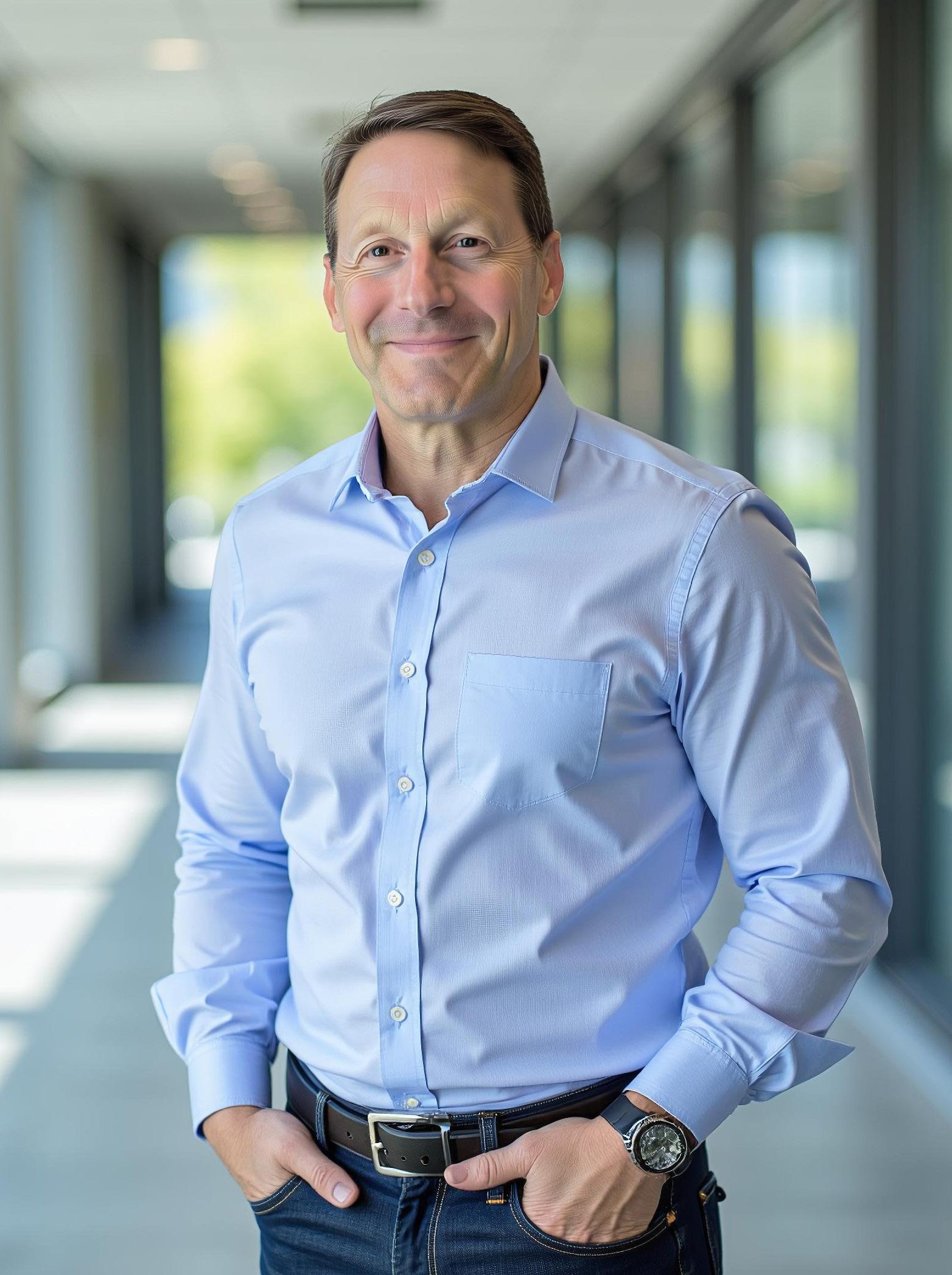
John Durocher Chief Customer Officer, Calix
John Durocher didn’t just take on the role of Chief Customer Officer at Calix—he stepped into a mission. With a long career shaped by leadership roles at global giants like Salesforce and Accenture, John brings both strategic vision and a deep sense of purpose to his work. At Calix, he leads the awardwinning Customer Success organization, guiding broadband service providers (BSPs) as they transform communities and help bridge the digital divide. “We’re helping BSPs deliver experiences that truly matter to people. That’s exciting. But what really pulled me in was the builder mentality,” says John.
Before joining Calix, John served as Executive Vice President of Customer Success at Salesforce, where he led global teams focused on customer engagement and growth. Prior to that, he spent 17 years at Accenture, helping financial services clients navigate change and innovation. His time there laid the groundwork for what would become a lifelong passion— using technology to drive meaningful outcomes.
Over the years, John has earned recognition as a thought leader in Customer Relationship Management. He has authored numerous industry articles, developed software solutions for the financial services sector, and holds patents for tools that are now in use around the world.

Calix isn’t just innovating for innovation’s sake— it’s helping broadband service providers (BSPs) evolve into full-scale broadband experience providers (BXPs)
John’s leadership style evolved through experience, reflection, and a willingness to grow. Like many early in their careers, he once believed leadership meant proving strength, capability, and maybe even perfection. “Looking back, it’s a little embarrassing,” he admits. “No one expects perfection. What earns trust is being real, being self-aware, and showing you’re willing to grow.”
Over time, John came to see leadership not as directing from the front, but enabling from within. For him, it’s about listening with intent, supporting the team, and building a culture where people feel safe, valued, and aligned. “When that happens,” he says, “teams thrive— and so does the business.”
John points to moments of rapid change— industry shifts, new technologies, business transformations—as the real testing grounds for leadership. Those times taught him that adaptability, empathy, and clarity aren’t optional. At Calix, he leads with that mindset every day. Clarity, curiosity, and a relentless focus on the customer are what he believes define today’s most inspiring business leaders. Especially in fast-moving industries, where expectations keep rising, leaders must bring not only accountability but also the steady hand to guide teams through change.
For BSPs, customer experience is no longer a back-office function—it’s a competitive advantage. But as expectations soar, many BSPs struggle to deliver seamless, personalized experiences across every stage of the subscriber journey. “Too often, systems
are fragmented, teams are siloed, and the subscriber experience becomes inconsistent,” John explains. “BSPs are expected to behave like world-class consumer brands, but they often don’t have the infrastructure to support that kind of execution.” That’s where Calix steps in.
Calix helps BSPs align their operations around the entire subscriber lifecycle—from acquisition to onboarding, support, retention, and growth. By offering a powerful platform and actionable insights, Calix helps ensure that every subscriber touchpoint is unified, fast, and personal.
Whether it’s activating a service, resolving an issue, or offering a timely upgrade, Calix tools like CommandIQ, Support Cloud, and Engagement Cloud help BSPs meet their customers where they are—with the right message at the right time. “We partner with GMs and their teams to help them shift from being utility providers to becoming Broadband Experience Providers (BXPs),” says John. “It’s about creating value at every step.”
From the start, Calix built its strategy around a simple belief: when its customers succeed, Calix succeeds. That thinking shows up everywhere— from how the company designs its platform to how it supports its partners. Whether that’s growing revenue, reducing churn, or helping BSPs better serve their communities, the goal remains the same: deliver exceptional experiences that drive loyalty and long-term success.
Feedback loops, advisory councils, regular check-ins, and insights from Calix Cloud ensure the company stays close to the customer. These insights shape everything from product roadmaps to training programs.
Most importantly, every team—from product and engineering to marketing and support— operates as one. “We’re all aligned around one goal: helping our customers go further, faster,” says John. That’s also why Calix continues to invest in its people, its platforms, and programs like Calix University—designed to scale success across every stage of the subscriber journey.
Calix considers data as a bridge that connects insights to action, strategy to impact, and businesses to the people they serve. The company’s mission is clear: level the playing field for BSPs of all sizes by democratizing access to deep subscriber insights. John believes that when every team—from marketing to support—has access to the right data, magic happens. “We empower our customers to engage smarter and act faster,” he says.
But it’s not just about access—it’s about impact. Calix is simplifying operations through a growing suite of managed services, allowing BSPs to focus on delivering truly standout experiences. With less time spent on operational headaches, providers are free to evolve into what Calix calls “BXPs”—organizations that
put subscribers first, foster loyalty, and unlock long-term growth.
Technology is making this transformation not just possible, but practical. Artificial intelligence (AI) and automation are no longer futuristic tools—they’re becoming everyday essentials. Calix is harnessing these innovations to move customer support from reactive to proactive, and from generic to deeply personalized.
Take AI-powered Health Scores, for example. They help surface early signs of customer churn or growth potential, so teams can address them before they escalate. Within the company’s Success Cloud platform, guided journeys and built-in playbooks help ensure best practices are followed consistently across the customer lifecycle. And through smart automation, Calix can tailor messaging and recommendations based on where a provider is in their journey— whether they’re rolling out something new or expanding their reach.
Yet through all this innovation, the human element remains front and center. As John puts it, “AI and automation aren’t replacements for human relationships. They’re amplifiers.” That belief guides the entire Customer Success team at Calix, ensuring that while technology supports the mission, trust and connection remain at its heart.
From the start, Calix built its strategy around a simple belief: when its customers succeed, Calix succeeds

John’s leadership style was shaped by years of experience inside two global giants: Accenture and Salesforce. Each played a role in how he thinks about scaling success, leading teams, and creating impact.
At Accenture, John developed an appreciation for structure. Well-defined processes, he learned,
are essential when you want to replicate success at scale. But just as important was learning to navigate the unknown. He came to see discomfort not as something to fear, but as a signal that growth was happening. “Getting comfortable with being uncomfortable” became part of his leadership DNA. Then came Salesforce, where the lessons took on a more personal tone. Culture, he saw, wasn’t just a
company value—it was a strategic asset. “Culture eats strategy for lunch,” John says, quoting a line that captures the heart of his approach.
Those philosophies now live on in how Calix’s Customer Success organization is built. It’s a mix of structure and flexibility, with culture as the foundation and leadership as the driving force. John’s background in software also gave him a unique lens into the power of technology. To him, the best innovations don’t just automate processes—they elevate people. They enable better conversations, smarter decisions, and stronger results.
Today, customer success is being reimagined. Technology is making it possible to predict customer needs before they’re voiced, turning service into a proactive relationship. It’s helping organizations stay personal, even as they grow. And it’s breaking down silos—
uniting sales, marketing, support, and success around one shared goal: delivering real value.
Orange County Fiber isn’t just a BSP connecting homes—they’re reinvesting in the communities they serve. As a cooperative, they deeply understand the importance of trust and local impact. That’s why, when it came time to rethink their offerings, they didn’t just tweak what they had. They partnered with Calix to build a completely new strategy—one that focused on value, not volume.
Together, they created tailored packages with specific managed services designed to meet the unique needs of different subscriber segments. The results? Within just 48 hours of

Calix considers data as a bridge that connects insights to action, strategy to impact, and businesses to the people they serve
launching, they upgraded 100 customers. And within a week, they boosted their Customer Lifetime Value by 30%. Transformation, it turns out, doesn’t always take years—it just takes the right mindset and the right partner.
Further up the coast in Oregon, Beacon Broadband took a different but equally inspiring approach. With help from the Calix Customer Success team and Calix University, they launched a digital literacy class for seniors. This wasn’t just about teaching tech— it was about building bridges.
The program paired seniors with local high school students, creating an unexpected but beautiful exchange. While seniors learned to navigate the internet and protect themselves from online threats, students were introduced to the broadband industry and the responsibility that comes with it.
Confidence grew. Friendships formed. Generations connected over shared curiosity. “This kind of initiative is what community broadband is all about,” said John. “It’s where technology meets purpose.”
As BSPs evolve, so do the expectations of the people they serve. For Calix, the next big growth opportunity is to help providers become true BXPs. That means delivering personalized, consistent, and meaningful interactions at every touchpoint—not just during installation or support calls, but throughout the entire customer journey. John sees Customer Success as the engine powering this shift. “Our role is to make sure our customers realize the full value of the platform,” he explains. That includes guided success journeys, data-

For Calix, the next big growth opportunity is to help providers become true Broadband Experience Providers (BXPs).
driven playbooks, executive engagement, and real-time health insights. Each piece is designed to make complex things feel simple and achievable.
But for John, it always comes back to the human side. “While technology is key, people and relationships remain at the heart of everything
we do,” he says. “Because trust and partnership are what truly drive long-term growth—for our customers and for Calix.” It’s a belief that runs through everything the Customer Success team builds and supports: that great broadband isn’t just fast—it’s thoughtful, responsive, and rooted in genuine connection.
Wa n t t o S e l l o r fi n d
I nve s t o rs f o r yo u r
B u s i n e s s ?
Bill Tennant is the Chief Revenue Officer at BlueCloud, where he drives strategic growth, builds high-impact partnerships, and leads enterprise adoption of transformative technologies. With nearly two decades of experience spanning finance, sales, and customer success, Bill is known for delivering measurable business outcomes through innovations like Generative AI and advanced analytics. Under his leadership, BlueCloud was named Snowflake’s Americas Growth Partner of the Year, and Bill has been recognized by the Tampa Bay Business Journal (40 Under 40) and CRN (Next-Gen Solution Provider Leader). His vision centers on co-created value, responsible governance, and scalable, AI-powered solutions. A passionate mentor, Bill champions a leadership style rooted in curiosity, empathy, and integrity — and continues to guide enterprises in unlocking sustained competitive advantage through innovation.
In this exclusive interview with CXO Outlook, Bill shares insights drawn from two decades of growth leadership across industries. From demystifying the practical adoption of Generative AI to building strategic partnerships that go beyond surface-level alliances, Bill offers a masterclass in aligning innovation with impact. He emphasizes that responsible AI isn’t a compliance requirement—it’s a catalyst for agility, transparency, and sustained value creation.

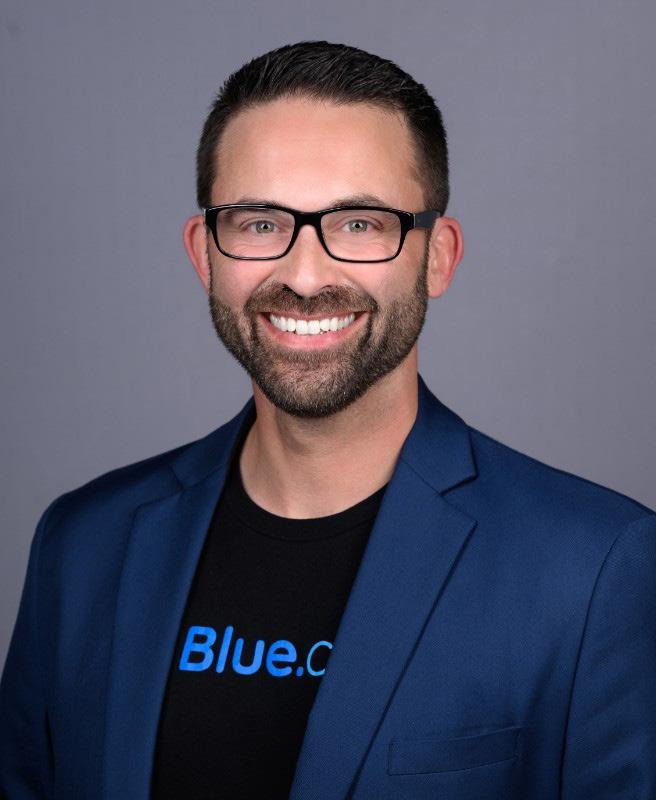
Bill Tennant Chief Revenue Officer, BlueCloud
The best partnerships aren’t built on shared logos—they’re built on shared accountability. True alliances form when both sides bring vision, trust, and a willingness to adapt together
You’ve had an impressive journey spanning nearly two decades across various industries. What pivotal moments or philosophies have shaped your approach to driving growth and innovation at BlueCloud?
Some of the most meaningful lessons in leadership don’t come from boardrooms—they come from the ground floor. I learned that early, working in my family’s car rental business in Buffalo. At a young age, I was exposed to what it means to serve customers, watch costs, and build something that matters. That environment taught me that success isn’t promised—it’s earned, and it has to be sustained through discipline and trust.
While I began my professional path studying finance and accounting, I was quickly drawn to roles that allowed me to be closer to growth— closer to people. I spent years in sales and customer success roles across industries, supporting organizations of every size—from startups to Fortune 50 enterprises. Those experiences taught me how value is created across an enterprise, and more importantly, how it’s lost when strategy and execution become disconnected.
One pivotal moment came during the early cloud transformation wave. I found myself leading go-to-market and operational strategy across multiple regions, and I began to see transformation differently—not as a technology event, but as a long-term operating model shift. I
came to believe that growth isn't just a goal—it's a system. One that requires alignment, rhythm, and a deep commitment to outcomes.
That belief has guided how I have helped to scale multiple businesses. At BlueCloud, we’ve built a model that pairs speed with trust, and agility with accountability. And while we’ve hit some strong business milestones, I’m most proud of the fact that we’ve built them without cutting corners—by investing in our people, staying close to our clients, and making every decision through the lens of long-term value.
Under your leadership, BlueCloud has achieved significant milestones, including elite partnerships and industry accolades. What has been your strategic playbook for building such high-impact alliances, particularly in the age of Generative AI and machine learning?
The best partnerships aren’t built on shared logos—they’re built on shared accountability.
Over the years, I’ve learned that true strategic alliances are forged when both sides bring something to the table beyond commercial interests: shared vision, mutual respect, and the willingness to adapt together. That means going beyond certifications and go-to-market handshakes. It means embedding early—at the design stage, at the roadmap stage, and in the outcomes.
In today’s AI-driven landscape, where the technology is evolving faster than any of us expected, what partners want most is clarity. They want someone who can move with them, not behind them. Our most effective alliances have been the ones where we’ve aligned not just on what to build, but why—and how to scale it responsibly.
If there’s a principle I keep coming back to, it’s this: partnerships are only as strong as the outcomes they deliver. If you can keep that north star in focus, the rest tends to follow.
Generative AI and advanced data analytics are transforming how organizations operate. How is BlueCloud helping clients harness these technologies to unlock tangible business value—both internally and in customer-facing solutions?
The challenge for most organizations isn’t understanding that AI is powerful—it’s knowing how to make it practical.
At BlueCloud, we focus on helping clients move from experimentation to enablement. That means embedding GenAI and machine learning into real operational flows: automating reconciliations in finance, optimizing inventory in supply chains, or accelerating data migration in legacy environments. We treat AI not as a product to be deployed, but as a capability to be matured. One principle we hold firm is that AI must be measurable. That’s why we build frameworks around every solution we deliver—measuring time saved, process improvements, adoption rates, and cost efficiencies. In one case, a financial client cut months of manual effort using a GenAI-powered migration engine we co-designed. That kind of impact isn’t about hype—it’s about aligning technology with pain points and outcomes.
Internally, we take the same approach. We use GenAI to accelerate onboarding, streamline code reviews, and support knowledge transfer across global teams. It’s helping us serve clients faster, but also train better, scale smarter, and adapt more quickly.
As a strong advocate for data governance, how do you see the balance between innovation and responsibility evolving—especially in complex enterprise environments?
This is one of the most important conversations happening in AI right now—and it's one that doesn’t get nearly enough attention.
We’re seeing a new era where governance can no longer be treated as a compliance checkbox. It has to be built into the architecture of innovation itself. Because the moment AI enters critical workflows, the stakes change. Whether you're making decisions about a patient, a portfolio, or a supply chain, you need to trust that the system is transparent, auditable, and aligned with your values.
In my experience, responsible AI is not a drag on innovation—it’s a prerequisite for it. The enterprises that are leading the way are the ones building governance into their foundation, not layering it on later. At BlueCloud, we’ve learned that the earlier you address access, lineage, explainability, and human oversight, the faster you can move.
We often say: if the business can’t trust the output, the project isn’t ready. That simple rule has saved a lot of time—and strengthened a lot of outcomes.
From your perspective, what are the emerging trends or untapped opportunities that businesses should be preparing for when it comes to AIpowered transformation?
We’re entering the phase where AI goes from being an innovation tool to a core business capability—and that shift brings both opportunity and responsibility.
AI isn’t just a product—it’s a capability that must mature over time. The real challenge isn’t proving its power, but embedding it into workflows that drive measurable business value
One trend I’m watching closely is the emergence of domain-specific models. More companies are realizing that general-purpose AI has limits when it comes to competitive advantage. The future lies in tuning models to your language, your risks, and your workflows. That’s where AI becomes a differentiator—not just an assistant.
Another is the rise of AI-native products. We’re seeing more clients build tools where AI isn’t an add-on—it’s the core engine. That could be a risk triage platform, a smart routing tool, or a real-time planning app. What they have in common is that they’re solving business problems and automating decisions with AI, not just analyzing them after the fact.
The third—and perhaps most underestimated— is workforce transformation. The organizations that are getting this right are not the ones replacing people with AI. They’re the ones augmenting them. They’re giving finance teams copilots for forecasting. They’re giving operations teams faster paths to action and building agents or a team of agents to unlock exponential productivity. The real unlock comes when AI is not just a tool, but part of how the business thinks.
Collaboration and joint ventures seem central to your vision. Can you share an example where a strategic partnership pushed the boundaries of what’s possible in tech and strategy?
One that stands out involved a global manufacturing client navigating serious complexity—legacy systems, slow reporting, fragmented data access. Their goal wasn’t just modernization. It was reinvention.
We began by working with a small team to stand up a modern analytics environment. But what unfolded was something much bigger. As trust grew, we expanded into data ingestion, real-time reporting, AI-powered inventory planning, customer support through AI—even product information management. What started as a focused project evolved into a strategic operating platform for the entire enterprise.
The most interesting part wasn’t the technology—it was the speed of the evolution. Because both teams were aligned on vision and outcomes, we were able to iterate quickly, take calculated risks, and move from ideas to impact without waiting for perfection.
That experience reaffirmed something I believe deeply: the best partnerships are the ones that make room for discovery. When you build with trust, you often build something bigger than anyone expected.
You’ve received numerous honors, including TBBJ 40 Under 40 and CRN Next-Gen Solution Provider Leader. What personal mindset or daily habit keeps you motivated and grounded through such a fast-paced, high-impact career?
For me, it’s about staying connected to what matters—and making space to reflect on it daily.
Every morning, I ask myself three simple questions: What matters most today? Who needs support? Where are we creating value? That small habit helps cut through the noise and keeps me focused on the people and priorities that matter.
I also stay close to the work. I make time for sprint reviews, client sessions, and hallway conversations. Not because it’s required—but because proximity sharpens judgment. It gives you a better read on what's working, what’s not, and where the real opportunities lie.
But the truth is, what motivates me most is watching others grow. Seeing someone take on a new challenge, step into leadership, or bring an idea to life—that’s the fuel. Recognition is nice. But the real reward is building something lasting, with people who care deeply about doing it the right way.
Peter Aitken leads the development of Kantar’s latest CX methods, and supports Kantar’s most cutting-edge CX programmes, which regularly win awards. He co-authored the Global Customer Experience Standards with Bain & Company and Qualtrics, and developed Kantar’s Meaningfully Different Experience method, integrating brand measurement into CX.
Between 2023 and 2025 the Kantar CX team with our clients won 5 UK and international awards, including Best Use of Customer Insight by the Institute for Customer Service for our work with Virgin Atlantic in 2024 and Nationwide in 2025, and Gold at the European Customer Experience Awards with Hyundai for Best Customer Insight in 2024.
Recently, in an exclusive interview with CXO Magazine, Peter shared insights on the role of empathy in delivering exceptional customer experiences, significant career milestones, personal hobbies and interests, future plans, words of wisdom, and much more. The following excerpts are taken from the interview.

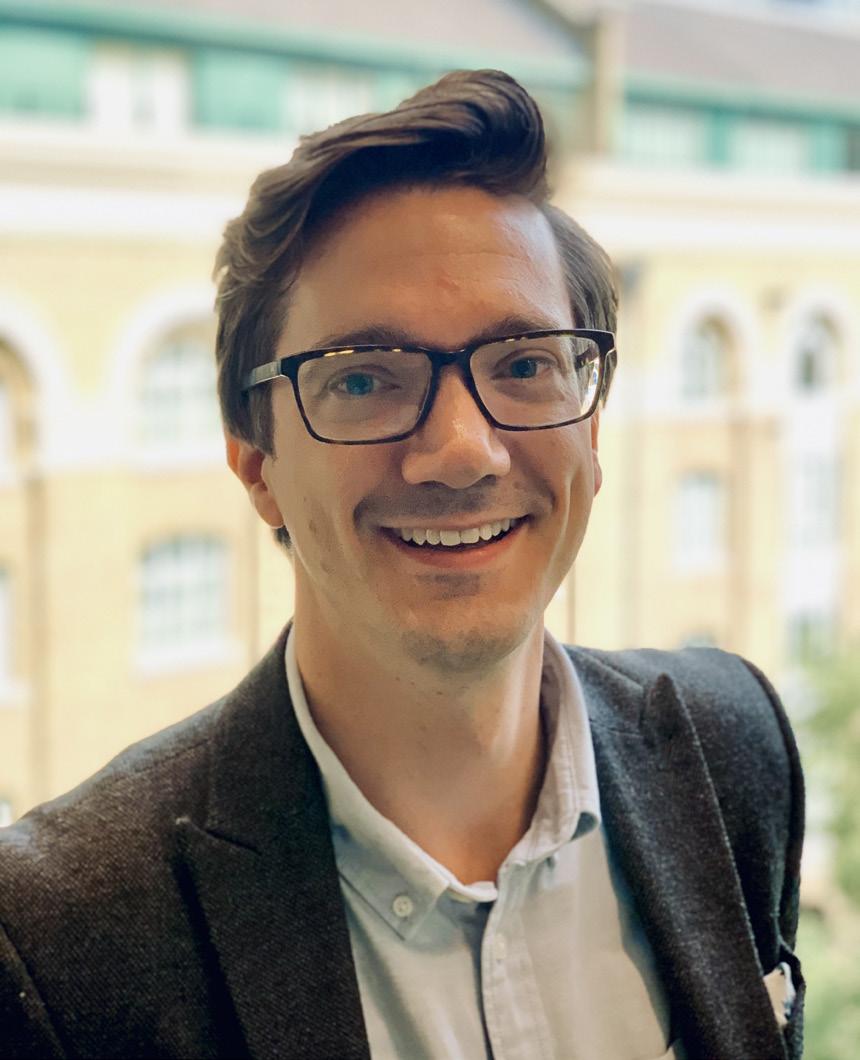
Peter Aitken
Senior Director, Head of Customer Strategy and Insights, Kantar
Empathy is at the heart of great customer experience. Businesses must deliver on both functional and emotional needs while creating interactions that feel truly unique and memorable
Hi Peter. What drives your passion for customer experience and strategy?
Customer Experience brings together all the areas I love: understanding people, solving problems, and using insight to make things better. I've always been fascinated by people— why they do what they do, and how experiences shape behaviour. That started back in school when I studied psychology, sociology, and philosophy, and continued through my degree in Psychology and Neuroscience. A huge focus of this was how experiences affect memories and create connections in the brain. And now, 20 years later, I’m still exploring and learning this.
I love helping organizations improve how they connect with their customers and seeing the impact that comes from doing CX right – both for companies and making everyday life just a little bit better. It's the perfect mix of human insight and strategic thinking.
What do you love the most about your current role?
I’m very fortunate at Kantar that I get to work with a brilliant, diverse team. Whether it's strategists, researchers, designers, system integrators, project managers, or our sales team – the magic happens when we bring different minds together.
I’m very hands-on and like to work closely with the team—helping shape our thinking, digging into the detail, analysing the data, and helping teams develop insights and strategies for our clients. I get to work with amazing clients, across industries, who trust us to help shape their customer experience.
Right now, I’m working on Kantar’s latest methods and solutions, applying Kantar’s marketleading brand measurement IP into customer experience. I also get to travel, speaking at events and conferences, and delivering client workshops with Kantar’s Customer Experience teams across the world. These give a real buzz, as you have to put yourself out there, on stage. Plus, the positive response, and discussion that a good workshop instigates, is deeply rewarding.
How do you balance creativity and datadriven decision making in CX?
Good data helps spark great ideas. It tells you where the problems are, but also what’s working well. Over my career, I’ve worked as both as a statistician, and an experience designer. What I’ve learned is that creativity is even stronger when it’s grounded in insight. We use data to get a sense of what is going on, but it never gives the complete customer story. We need creativity to form hypotheses on what to explore further, qualitatively with real people, and then form ideas for better experiences. And when we test those ideas, we come back to the data to see what’s really made a difference.
What role do you think empathy plays in delivering exceptional customer experiences?
Empathy is central to Kantar’s approach for understanding customer experience – which we
call ‘Meaningfully Different Experiences’. Put simply, a business must deliver on both functional and emotional needs, plus create an experience that feels unlike any other provider. Our data shows that delivering on these aspects is highly predictive of future revenue growth.
It makes sense really – your product or service must be created with a true understanding of your customer to work effortlessly, build an emotional connection, and stand out from the rest. That’s where empathy comes in. It’s about seeing the world through your customer’s eyes—what they need, how they feel, and what matters most to them, how they feel about the alternatives. That means going beyond the numbers and listening to real customer stories. In practical terms, we don’t just look at survey numbers; we read verbatims, conduct interviews, observe natural behaviour, watch screen recordings.
With empathy, you’re creating experiences that truly connect with people, in a way that’s meaningful, and different.
is your leadership
and how do you keep team engaged and motivate them?
I believe in leading by working alongside the team. I’m not one for sitting on the sidelines. I prefer to get stuck in and solve problems together. I’m inspired by people who deliver great work, day in, day out, and by those who dive deep and bring new insights to the table. I try to create a culture where everyone feels valued and heard. When people feel trusted, appreciated and part of something meaningful, they’re naturally motivated to do great work.
How do you stay current with the latest trends and technologies in customer experience?
The CX field moves so fast, and there is some amazing work taking place right now. I stay close to what’s happening in the industry by getting actively involved; speaking at events, reading widely, following thought leaders, and sharing our own ideas on platforms like LinkedIn. Plus, I speak to clients most days, and run regular workshops bringing CX leaders together. Those experiences are fantastic because in sharing our latest thinking, I’m testing the reaction, and hearing questions and ideas from others. This usually prompts me to go back to the data, ask more questions of our clients, and then evolve the thinking.
Collaborating with other experts, like in my work with Bain & Company and Qualtrics on the Global CX Standards, helps me stay sharp and learn from other industry leaders. This really forced us all to pool the latest best practices and forward-thinking ideas.
I also highly recommend serving as an awards judge. I do this for the UK CX Awards, and get to see so many incredible things people are doing in organisations big and small. This really inspires me to push our work forward.
What has been your most careerdefining moment that you are proud of?
I'm going to cheat and highlight two things! First, leading the creation of Meaningfully Different Experiences at Kantar has been incredibly rewarding. This approach is now rolled out globally and is live on at least 30 projects. It's helping organisations connect their customer experience more closely with their brand, and showing just how much CX can drive commercial results. Seeing it have such an impact for clients –
and being asked to share it at major conferences and events – has been incredibly rewarding. The second is co-leading the development of the Global Standards for Customer Experience teams with Bain & Company and Qualtrics. It felt career-defining because we were essentially capturing what “good” looks like in CX practice – not just for one company, but as a guide for the industry globally. When we launched the standards last year, the response exceeded our expectations: it’s been downloaded over 2,000 times and prompted a lot of positive conversation in the CX community
Seeing it picked up by industry media (including a series of articles on CX Dive) and hearing feedback from CX leaders that they’re using those standards to shape their programs was incredibly rewarding. I’m proud of it because it wasn’t just a personal achievement; it was a collaborative effort that hopefully raises the bar for everyone.
are your passions outside of work?
Outside of work, I’m happiest spending time outdoors with my family in the Peak District –camping, walking, or just relaxing in the garden with my wife and two young children. Getting out in the hills for a walk, or digging in the raised beds helps me switch off, and brings a little perspective when I’m back at work. I also love playing guitar; it’s my way of escaping for a few hours and getting into a creative flow. Writing and public speaking are long-time passions of mine as well. I enjoy sharing new ideas, whether through publishing thought leadership, hosting webinars, or presenting at events. Ultimately, I find that these activities keep me curious and energized – qualities that I hope make their way back into my work.
Data sparks great ideas, but it never tells the full customer story. Creativity, combined with deep insight, helps shape experiences that resonate beyond mere numbers
Where do you see yourself in the next 5 years?
At the moment, my focus is on scaling our successful approaches globally. I hope to have helped embed the idea of experience as a key driver of business growth in many more organizations over the next five years. Personally, I’d love to continue writing and remaining active in the CX community. We currently have some really exciting articles and interviews planned, any maybe it’ll come together as a book. One day, I’d love to produce something that draws from the expertise of a range great people doing really exciting things – whether CMOs or people in operational roles – with inspiring examples and data that illustrates the principles that lead to commercial success. Who knows, maybe it could become part of the canon of management reading. But either way, as long as I’m doing
interesting work, that has a net-positive impact on the world, then I’m happy.
What advice would you give to organizations looking to build a more customer-centric culture and improve their CX capabilities?
Start with your culture. Customer experience isn’t just a function—it’s a mindset that needs to live across your whole organisation. Make sure your people understand the role they play and why it matters. Then get the basics right: listen to your customers, act on what they say, and link those actions to business results. Focus on the moments that matter most to your customers, and find ways to stand out. Most importantly, build empathy into everything you do. If you truly understand your customer, you’ll make better decisions and deliver experiences that people remember.
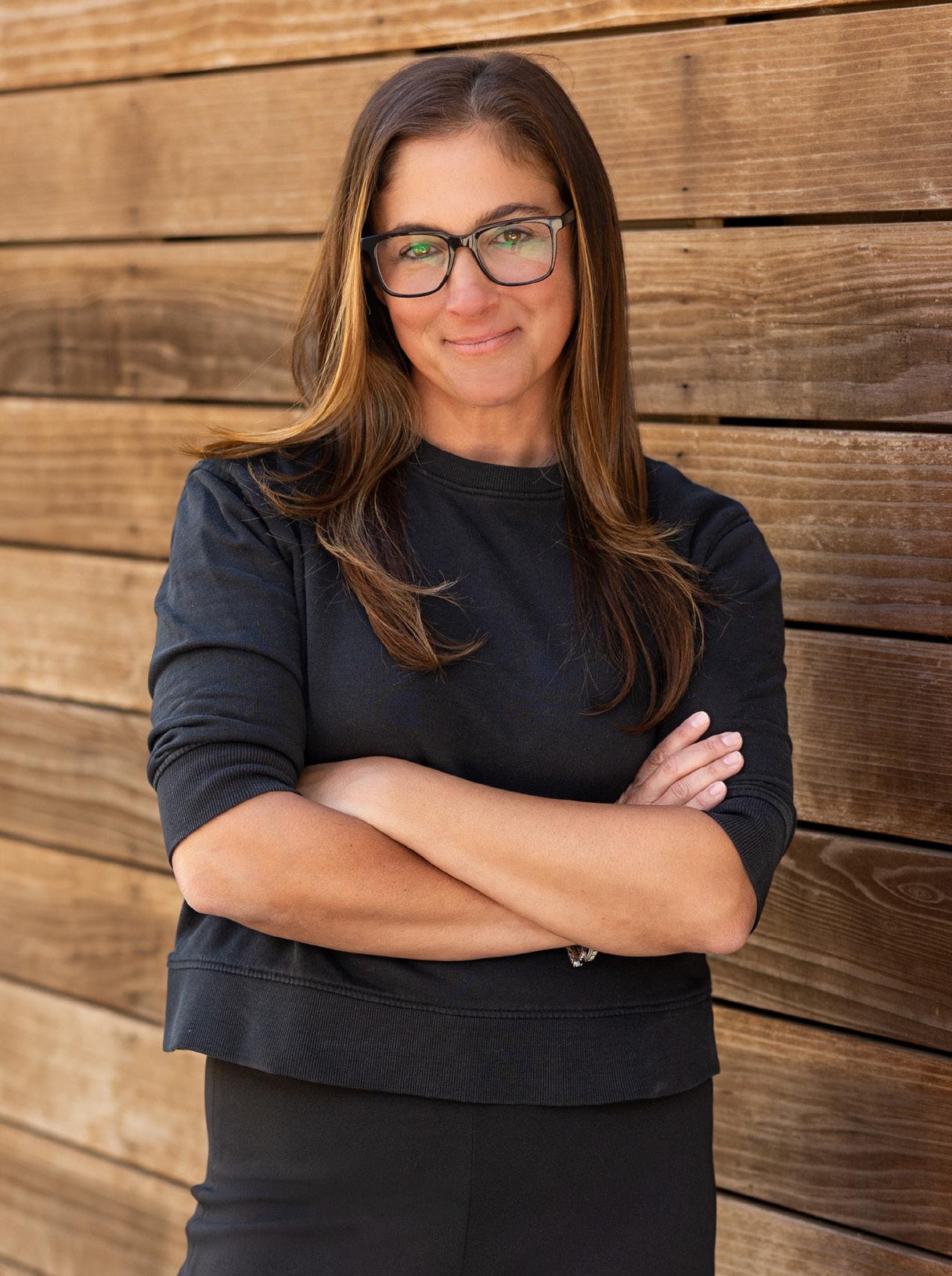
Karen Gray Chief Customer Officer, Centerbase
CHIEF CUSTOMER OFFICER
Karen Gray's path to customer leadership is far from conventional. Starting her career in law, she honed skills essential for business success: critical thinking, risk assessment, and precision. But those same skills turned out to be just what she needed to thrive in the business world. “Practicing law taught me to anticipate challenges, mitigate risks, and approach problem-solving with rigorous analytical precision,” Karen says. That foundation gave her a sharp, strategic lens for navigating complex customer issues. It also helped her balance two essential priorities: advocating for customers while protecting the company’s interests.
As she moved into technology and began leading revenue teams, Karen’s legal instincts carried over. She quickly saw that success wasn’t just about getting a signature on the dotted line. It was about building trust, solving real problems, and creating experiences customers want to return to. Along the way, Karen developed a customer philosophy that now defines her role as Chief Customer Officer at Centerbase. “Understanding customer needs isn't a department function,” she says. “It's the core of our business strategy.” That belief shows up in how she leads cross-functional teams and builds connections between product, sales, marketing, and support.
Karen’s approach is also deeply rooted in data. She learned early in her legal career that arguments need evidence—and that principle still guides her today. “One of my favorite sayings at work is, ‘Nice story, show me the data,’” she shares. For her, data isn’t just numbers on a dashboard. It’s a window into what customers need, how they behave, and where the business can do better. Still, she’s quick to point out that data alone isn’t enough. “We can never lose sight of the individual human experience,” she adds. The goal is to blend insight with empathy—to build a customer journey that feels both smart and personal, every step of the way.
Karen’s move from law to technology wasn’t a sudden switch. It was a steady shift toward where she felt she could make a bigger impact— closer to real-world problems and the people experiencing them. Her legal background gave her a sharp skill set. She could think critically, negotiate under pressure, and solve problems with clarity. But as time went on, she felt pulled toward a space where ideas moved faster and outcomes were more immediate.
“I wanted to be more directly involved in creating value and solving problems in real-time,” Karen says. The tech industry offered that. She was inspired by how quickly technology was reshaping businesses and lives. It wasn’t just about innovation—it was about action. “As someone who moves very quickly, both in my personal and professional life, the sheer pace of innovation and the tangible impact tech companies have on everyday lives was incredibly inspiring,” she adds.
Now, as CCO at Centerbase, Karen brings that same urgency and intention to her

Karen's ultimate goal is to help her team deliver measurable value, strengthen customer relationships, and contribute to the company’s long-term success
leadership. She’s the voice of the customer in the executive room. Her job is to make sure customer insights are part of every big decision, from product design to long-term strategy. She works closely with product teams, sales, and support to connect customer feedback to product development. Her goal is to ensure the customer’s voice is heard at every step—before, during, and after launch. “It’s about more than features,” Karen says. “It’s about delivering continuous, tangible value to the customer.”
Karen sees data as the foundation for scaling customer success in a meaningful, repeatable way. She explains, “While I believe that empathy and strong relationships are crucial, true scalability and predictable outcomes come from rigorous analysis of objective customer data points.” Karen admits that working with customer data isn’t always easy. It takes discipline and commitment. But she also knows it’s essential. Data shows what customers actually do—not just what they say. That kind of insight helps Karen and her team identify patterns, predict issues, and act fast.
Understanding customer usage metrics is a key part of her work. Karen focuses on linking product features to engagement, satisfaction, and long-term value. She believes customer success is measurable— and that it should tie back to business goals like retention and growth. But the CCO role isn’t just about numbers. It’s deeply crossfunctional. Karen sees herself as a connector, bringing departments together with a shared goal: the customer. “You cannot be the voice of the customer within your organization
unless you are being heard by the requisite stakeholders,” she says.
She creates space for that alignment through structured workshops and open communication channels. Sales can share market feedback. Support can raise recurring pain points. Product can listen, learn, and adjust. That feedback loop is constant—and essential. Karen balances directness with empathy. She understands what each team needs, what they’re up against, and how they can contribute to a better customer journey. Her mission is simple: take the insights from data, pair them with strong collaboration, and turn them into real results. Her ultimate goal? To help her team deliver measurable value, strengthen customer relationships, and contribute to the company’s long-term success.
Karen believes strong leadership starts with clear communication. It’s a principle that guides how she works with both her team and customers. “To be an effective leader, you must be a strong, clear communicator,” she says. For Karen, that means blending empathy with directness. She listens first. She creates space where people feel safe
to speak. Then, when the time comes to make decisions, she’s transparent and precise.
“Empathy is important because it helps you understand where the other side is coming from,” Karen explains. “But being direct is just as necessary. It doesn’t help anyone to hedge or speak in false narratives.” Her approach builds trust. It helps teams stay focused and accountable. She believes that when people know exactly where they stand, they perform better. They’re more confident. They solve problems faster. And they grow together.
Karen also puts a strong focus on mentorship. She sees it not as a bonus, but as a key part of team development. “Mentorship isn’t just a perk,” she says. “It’s a critical investment in both individual potential and collective strength.” She encourages senior team members to take the lead in sharing what they’ve learned. It creates an environment where growth happens every day, not just during performance reviews. It also strengthens team bonds.
Rapid growth can test even the strongest teams. But Karen stays grounded through clear communication and a shared sense of purpose. She makes sure every team member knows how
Karen makes sure every team member knows how their work connects to the bigger picture. She celebrates wins that reflect company values and strategic goals

their work connects to the bigger picture. She celebrates wins that reflect company values and strategic goals. When things move fast, Karen cuts through the noise. Her directness keeps the team focused. Her empathy helps spot fatigue and support well-being. The result is a resilient team that learns, adapts, and moves forward together.
Seeing a big shift coming in the world of customer success, Karen is excited to be
part of it. She says, “What excites me most about the future of customer success is its evolution from mere retention to a true strategic growth engine.” She believes the Chief Customer Officer is at the center of this change. The role is no longer just about solving problems—it’s about driving value and shaping the customer journey from start to finish.
Karen envisions a future where CCOs use data and AI to predict customer needs. Where
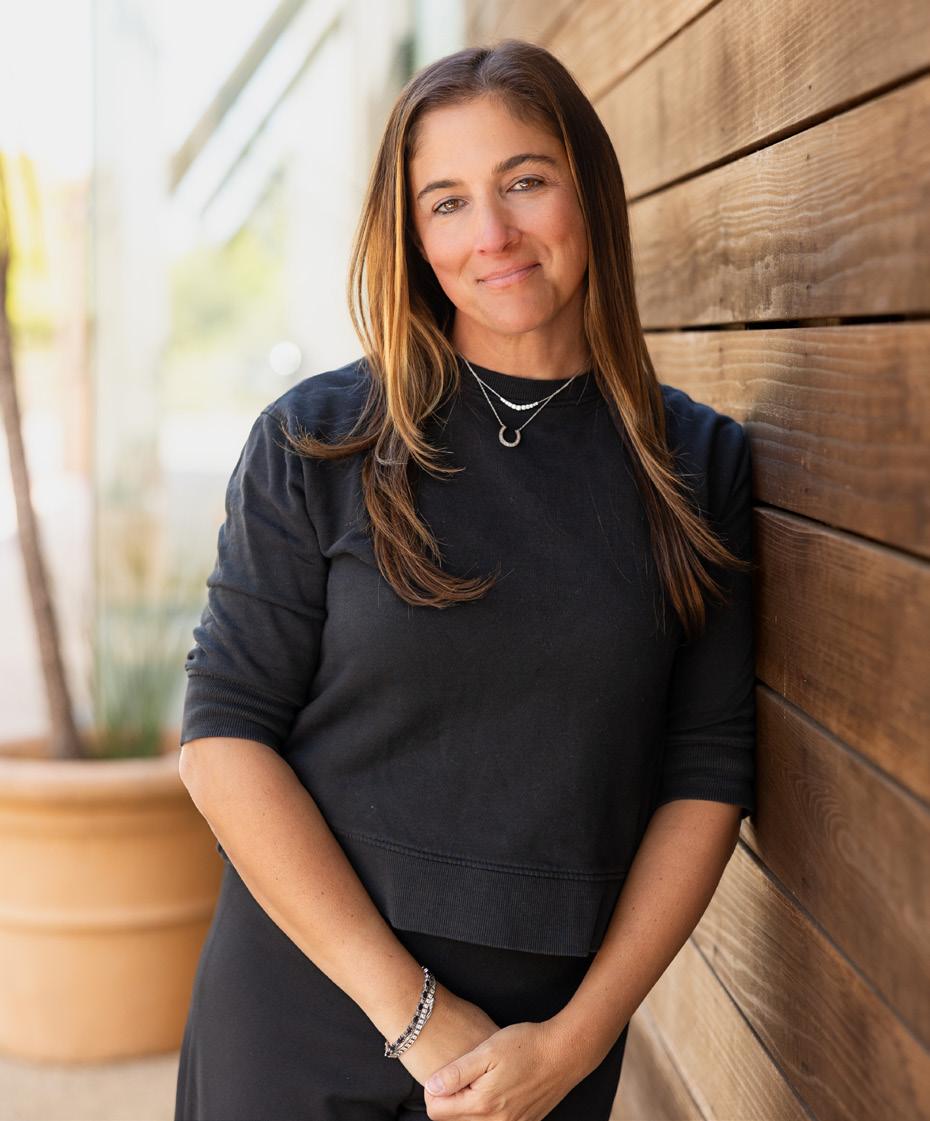
companies personalize experiences at scale. And where the customer’s voice isn’t siloed— it’s embedded in every team, from product to marketing. This shift means thinking ahead, not just reacting. For Karen, it’s not about managing churn—it’s about creating momentum. It’s about making sure customers succeed, grow, and stay loyal because they truly see the value.
Her goal is to leave behind a clear legacy. She wants to help build companies where customer success is part of the culture—not just a department. “I want to create a framework where every employee understands their direct impact on customer delight,” Karen says. “Where the customer’s success is unequivocally the company’s success.” To her, that’s what lasting impact looks like.

Mary Michael Sellers is an innovative executive with over 20 years of experience in educational technology, SaaS, and enterprise solutions. She approaches digital transformation as both an art and a discipline, applying an entrepreneurial mindset to complex challenges. As President of Scantron, she's transforming the company from a traditional analog brand into a modern intelligence platform. She's achieving this by integrating AI, cloud infrastructure, and user-centric design to deliver scalable solutions. Her focus is on redesigning how people interact with information for more intuitive and efficient experiences, rather than just upgrading tools.
Mary Michael's leadership emphasizes product thinking, operational rigor, and simplicity. She's driven global transformations and consistent growth by aligning innovation with scalable systems and meaningful experiences. She excels at connecting vision to execution, believing success lies in deep listening, rapid iteration, and designing solutions that feel essential. Her mission is to create better outcomes, where data drives actionable insights for individuals, organizations, and industries.
In this thought-provoking conversation with CXO Magazine, Mary Michael shares how data is no longer just about collection—it’s about creating meaningful, real-time insights that drive action. From AI integration to human-centered design, the discussion covers the evolution of data intelligence across education, government, and enterprise.


Mary Michael Sellers President, Scantron
Your career spans teaching, product innovation, and executive leadership. How has that shaped your leadership at Scantron?
My path hasn’t been traditional, but it has been deeply intentional. I started as a classroom teacher, where every choice directly impacted a student’s learning experience. That role instilled a deep sense of purpose and accountability—one that still grounds me today. When I transitioned into product innovation, it felt natural. Teaching is about solving real problems for real people. Product work, at its best, is the same—it requires empathy, insight, and the discipline to design for the user, not just the feature list.
In those roles, I honed a design-first mindset. I became focused on clarity, trust, and user experience, not just functionality. I also learned the importance of storytelling through data, connecting insights across functions and teams to build alignment and momentum.
Now, in executive leadership, I apply that systems view to every decision. I focus on aligning vision and execution, building empowered teams, and creating conditions that enable innovation to thrive and scale. At Scantron, that means solving problems that matter, removing barriers for our teams, and delivering real value to clients across education, enterprise, and government. My journey—from the classroom to the boardroom—has shaped me into a leader who listens first, moves with purpose, and leads with both empathy and rigor.
Scantron is an iconic name in data capture. How are you evolving it for today’s world?
Scantron’s reputation was built on precision, reliability, and trust. For decades, we’ve been

recognized for enabling secure, scalable data collection. That foundation still matters—but today, organizations don’t just need data; they need insight, clarity, and they need it fast.
The team at Scantron is incredibly energized, and it’s an honor to work with such outstanding professionals who are fierce stewards of Scantron’s legacy as well as the biggest cheerleaders for our innovation journey. We’re evolving from a data capture provider into a modern intelligence partner. This involves applying AI, cloud infrastructure, and seamless digital workflows to reimagine what’s
possible. We’re upgrading our assessment and survey platforms to generate real-time insights, reduce administrative burdens, and personalize outcomes. We’re integrating automation into scoring, enhancing survey adaptability, and delivering hybrid testing solutions that work in both paper and digital formats—because our clients don’t live in a one-size-fits-all world.
This is about honoring our legacy while expanding its impact through innovation. We’re amplifying what made Scantron trusted in the first place, while equipping our clients for a
Data should drive insight in real time—not lag behind behavior. Intelligence must be intuitive, embedded into workflows, and designed to empower people with clarity and confidence
data-driven future. We’re not just collecting answers; we’re enabling action.
How is data capture evolving across education, government, and corporate sectors? Are there trends that excite you?
We’re in the middle of a generational shift—AI isn’t just a tool, it’s becoming the connective tissue of how we learn, lead, and decide. We’re seeing education, workforce development, and data intelligence converge into continuous feedback systems that personalize and scale support in real time.
In education, this means moving beyond compliance-based assessment toward systems that adapt to each learner’s needs. In the corporate and government space, it means leveraging predictive analytics and automation to make decisions with more speed and precision. But with that power comes real responsibility. We need to design systems that augment human potential, not replace it. That means building for ethics, equity, and long-term impact.
We are heading into a future where personalization at scale isn’t just a differentiator — it’s an expectation. Whether in education, enterprise, or everyday systems, people will
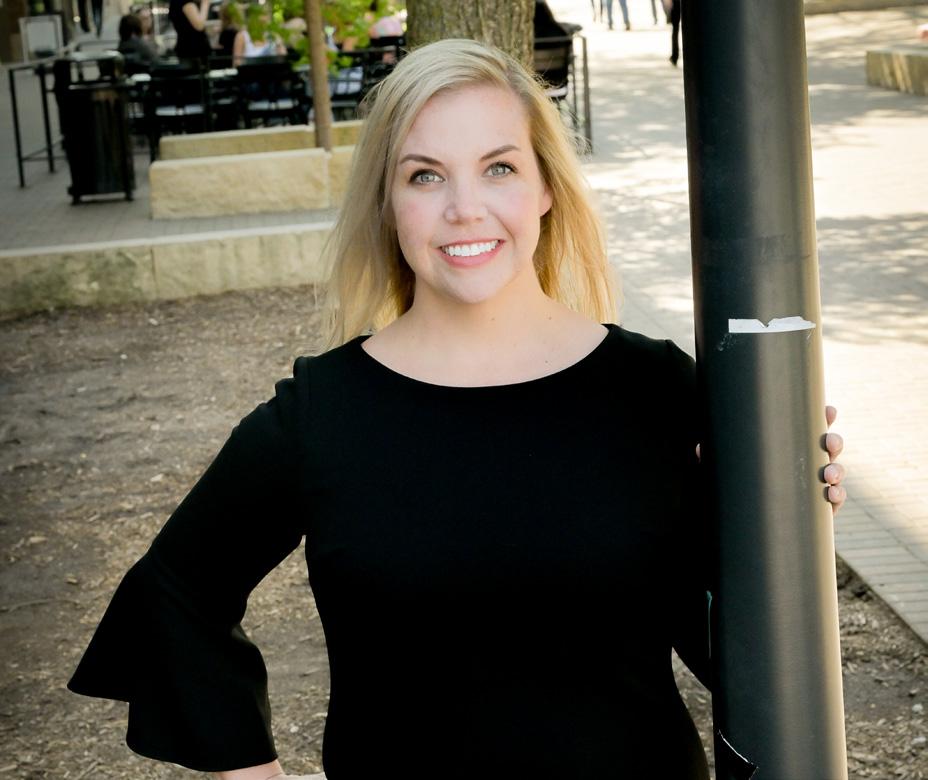
Innovation isn’t about disruption for its own sake—it’s about evolution. Great solutions respect what’s working while boldly redesigning the future with empathy, purpose, and adaptability
demand experiences that understand their context and adapt in real time. At the same time, as AI becomes more embedded in decision-making processes, leadership grounded in ethics, transparency, and human impact will be crucial — it’ll be the edge. The organizations that thrive will be those that build trust into the core of their systems. Moreover, the shift away from static data infrastructure is already underway. The next generation of platforms won’t merely store information — they’ll interpret it, act on it, and continuously improve based on what they learn. That’s the kind of world I want to help shape — intelligent, adaptive, and deeply human.
Can you share an initiative that reflects Scantron’s innovation strategy?
Innovation at Scantron means evolution, not disruption for disruption’s sake. A recent example is the launch of Scantron TestFlex, which combines the reliability of our legacy paper-based systems with the flexibility and speed of digital delivery. It allows institutions to adapt to hybrid testing environments without having to overhaul their entire infrastructure—meeting them where they are, while preparing them for where they’re going.
We’re also preparing to launch Scantron ProcessIQ, a business process automation tool designed to streamline workflows across education and enterprise, accelerating decisions, improving efficiency, and unlocking the full potential of people and processes. Whether you're optimizing operations in education, finance, or the public sector, Scantron helps you build a smarter, more agile organization— one process at a time. These products reflect a core belief: innovation should be additive. It should respect what’s working, while creating space for what’s possible. Innovation means staying true to our values while boldly redesigning our future.
How is Scantron adapting to the shift from transactional tools to experiencedriven solutions?
We’ve transitioned from building tools to designing experiences. This shift begins with rethinking our approach to data collection instruments, such as tests and surveys—not as one-time, transactional tools, but as vehicles for ongoing conversations that foster meaningful engagement. A test or survey shouldn’t merely collect answers; it should provide insights, build trust, and foster better outcomes.
We’re investing in experience design, realtime analytics, and integrations that empower organizations to take meaningful action. Whether a district leader is acting on student engagement data or an HR manager is using pulse surveys to improve retention, our platforms are built to respond, not just record.
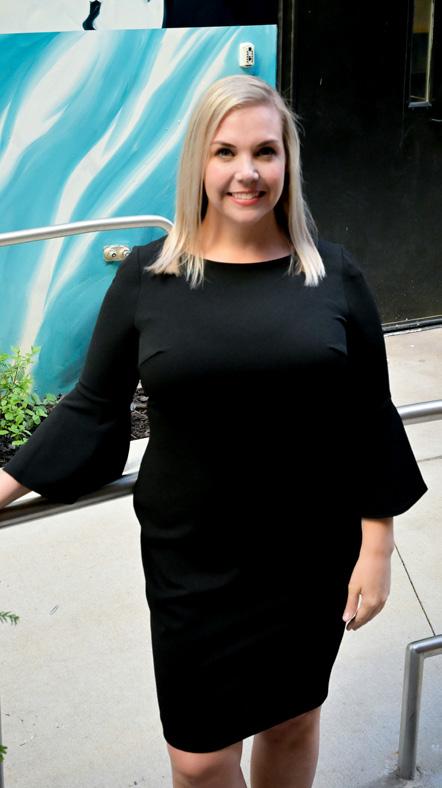
Great leadership isn’t about doing everything—it’s about doing the right things with clarity and care. Success comes from presence, discernment, and a deep commitment to what truly matters
This shift reflects a broader change in the market: accuracy is now a baseline expectation. What truly matters now is how people feel when interacting with our systems. Do they trust the data? Do they feel recognized? Do they feel empowered to take action?
Our priority is to design with empathy, purpose, and responsiveness. That’s how we create lasting value—and how we remain a trusted partner in a changing world.
What is your long-term vision for the future of data capture and assessment?
I see a future where data capture and assessment are no longer functions — they’re foundational experiences, seamlessly embedded into how we operate, learn, and lead. Throughout my career, I’ve been drawn to systems that unlock clarity. What’s always struck me is how often data lags behind behavior. My vision is to flip that dynamic. I want to build toward a world where insight happens in real time — where data doesn’t just document performance, it anticipates potential.
We’re entering an era where intelligence is ambient. The systems we design should feel intuitive, not intrusive — capturing the right signals at the right time, and transforming them into something immediately useful, actionable, and aligned with purpose. But this isn’t just about better tools. It’s about raising the bar on trust, design, and impact. Data done well doesn’t just inform decisions — it sharpens instincts. It empowers people to move faster, with more confidence, and with greater clarity of direction.
That’s the kind of future I’m building toward — one where intelligence is everywhere, and where every interaction becomes a chance to learn, adapt, and lead with intention.
On a personal note, what keeps you grounded and inspired as a leader?
As a mother of four, I’ve learned that leadership— whether at home or in the workplace—is built on a series of deliberate trade-offs. Every day, I make intentional choices about where to focus my time, energy, and presence. Over the years, I’ve come to believe that great leadership isn’t about doing everything—it’s about doing the right things, with clarity and care.
There’s a Nora Ephron story I return to often. She talks about juggling all the responsibilities in life—some balls are plastic, and some are glass. Drop a plastic one, and it’ll bounce. Drop a glass one, and it may shatter. That metaphor has quietly shaped the way I lead. I’ve learned to recognize which priorities are truly fragile and deserve my full, undivided attention—and, just as importantly, to give myself permission to let the plastic ones bounce. It’s not about perfection. It’s about discernment and presence. Whether I’m navigating a critical business decision or showing up for one of my children, I try to lead from the same place: grounded in values, clear on what matters most, and intentional in how I show up. That’s what allows me to be both resilient and responsive— and to model a kind of leadership that’s human, steady, and real.
At Scantron, what makes this work meaningful is that we lead this way together. As a team, we focus on the glass balls—what truly matters—and we do it with empathy, curiosity, and a shared commitment to making a positive impact. That clarity of purpose, paired with a culture that values people as much as performance, is what makes this not just a great place to work—but a place where we can grow, lead, and do work that lasts.
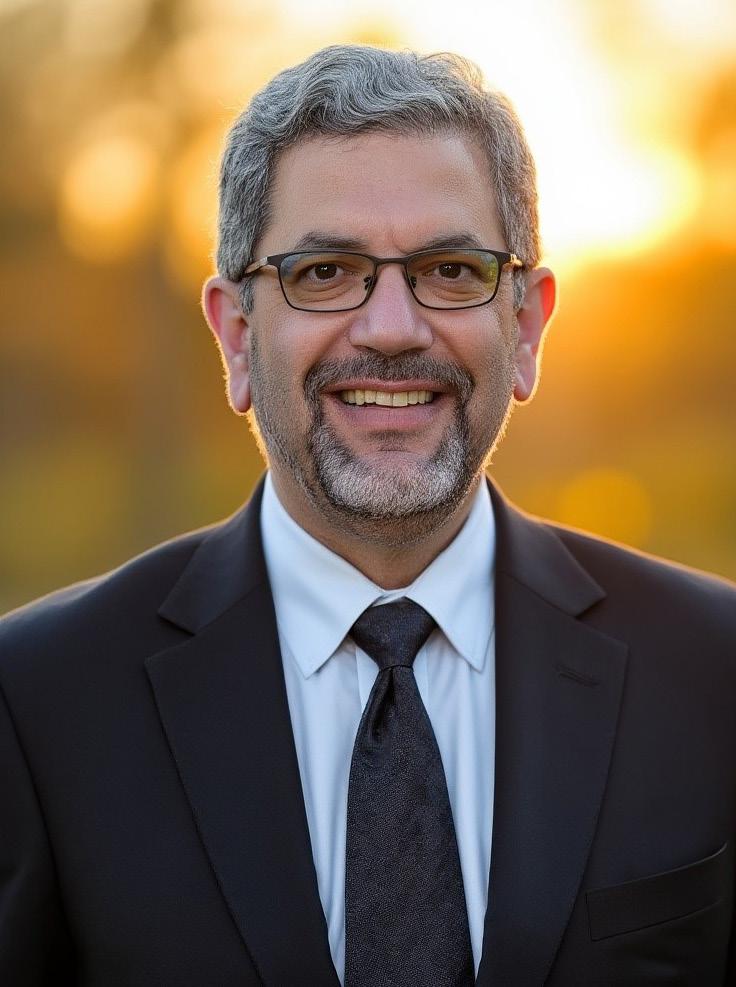
Richard Jacik Chief Digital Officer, Brillient Corporation
Richard Jacik is Senior Vice President and Chief Digital Officer at Brillient Corporation, where he leads teams helping government agencies embrace digital change. With more than 25 years of experience across both commercial and government sectors, Richard brings a deep understanding of how to design, build, and manage complex IT programs that drive real-world results.
At Brillient, his mission is clear: to make every interaction between government agencies and the people they serve seamless and efficient. Richard explains, “Our vision is to simplify every interaction between the government and the people it serves.
Whether it’s applying for benefits, accessing records, filing taxes, or requesting support, the experience should just work.”
For many public sector organizations, the challenge isn’t just outdated technology—it’s the lack of complete information. Agencies are often making decisions with only a small piece of the bigger picture. Richard and his team are working to fix that by making every kind of data—digital, analog, structured, or not—easy to access and use. We want to give agencies a full view of their customers,” he says, “so they can not only meet current needs but also anticipate what’s next.”
Richard sees digital transformation as more than just upgrading systems. It’s about rethinking

how services are delivered—especially in government, where operations must work within tight constraints and complicated policies. “This isn’t about cherry-picking the easy parts. It’s about improving mission delivery, even in the most complex environments,” he notes.
Innovation, according to Richard, begins with imagination. But it doesn’t stop there. “An innovation is simply an idea that’s growing up,” he says. For him, innovation must be managed, tested, and adapted in collaboration with clients and partners. It’s not limited to big breakthroughs. It can also mean small improvements made every day at every level of the organization.
“Innovation has to be practical to succeed. We’re not looking for perfection—we’re pushing for solutions that work, within real-world constraints,” Richard adds. That mindset shapes everything Brillient does, from advanced AI research in its ALICE Labs
to the hundreds of micro-innovations happening across client project environments.
One of the biggest challenges government agencies face today is the assumption that modernization is the same as transformation. Richard sees this confusion as a major obstacle to meaningful progress. He explains, “Many agencies focus on upgrading a single system or moving to the cloud. But if you don’t rethink how that system fits into the broader mission or improves the citizen experience, you’re not really transforming anything.”
It’s a common scenario. A new user interface is added, or legacy software is re-platformed. But the overall process remains the same. The forms are still there—just digital now—and often with less support available to help people navigate them. These kinds of upgrades are
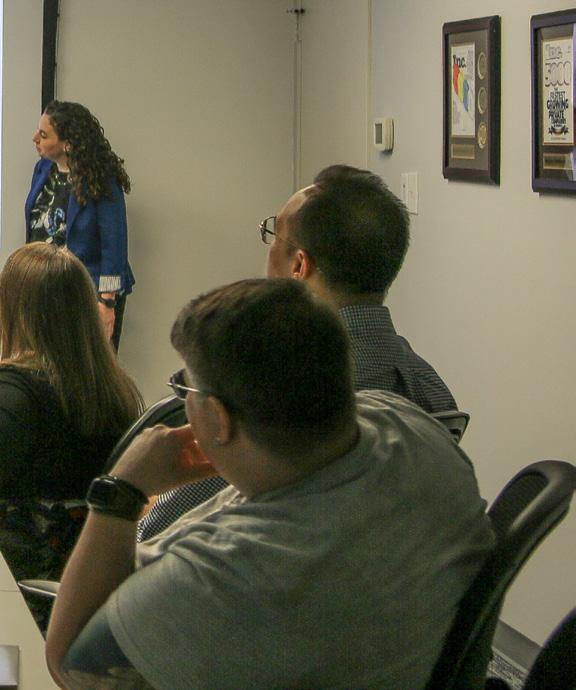
important, but they don’t always lead to better service outcomes.
Brillient takes a different approach. Its proprietary ALICE platform—short for Artificial Intelligence Cognitive Ecosystem— is built to complement existing systems, not replace them. ALICE adds intelligent automation and advanced data tools to what agencies already have. It allows teams to upgrade step by step, without having to rebuild everything from scratch. Richard says, “It’s about making smart upgrades in a flexible way. When you embed intelligence into existing processes, you create a path for agencies to move at their own pace—while still delivering visible, meaningful results.”
Brillient's proprietary Artificial Intelligence Cognitive Ecosystem (ALICE) platform adds intelligent automation and advanced data tools to what agencies already have
At the heart of this approach is a strong architectural foundation. According to Richard, good architecture absorbs complexity so that systems can evolve over time without becoming fragile or outdated. It also ensures that updates to one part of a mission process support, rather than disrupt, other processes. That focus on architecture also extends to user experience—on both sides. “You can’t have great citizen experiences without also thinking about the people behind the scenes,” Richard notes. “If your workers can’t easily use the tools, they can’t support the citizens properly.”
For Richard and his team, transformation has to work from the inside out. That means building systems that make life easier for both citizens and government employees. “It’s not about choosing one over the other. A good design works for everyone,” he adds. Part of Brillient’s strategy is to keep complexity behind the curtain. The goal is to make the systems simple to use—even if the back-end is anything but. Data ingestion, workflow

automation, and policy logic should all happen quietly in the background.
To make that possible, Brillient integrates policy experts directly into its development teams. That way, compliance becomes part of the design—not an afterthought. One of its innovations, ALICE Enhance, even uses AI to interpret government policy and recommend system configurations based on the rules. It’s so effective that it often flags contradictions between different policies before agency staff even spot them.
One particularly complex challenge involved designing middleware that could handle hundreds of distinct data types. The AI tools available at the time weren’t up to the job. So, Brillient built something better: NAIX, the Neural AI Executive. This internal orchestration layer manages an entire ecosystem of specialized AI agents, each optimized for a specific task. “No single AI tool could handle the whole job,” Richard says. “NAIX coordinates all of them to get the best result possible. It balances cost, quality, and accuracy in real-time.”
That insight—knowing when to create something new and when to build on what exists—defines Richard’s approach to leadership and innovation. For him, digital transformation isn’t just about tools. It’s about delivering practical change in the real world.
Richard has learned from exceptional leaders— and also from those who fell short. Both
shaped his perspective. With over two decades of experience managing digital transformation efforts around the globe, Richard understands what it takes to lead technology projects that actually make a difference. “Technology leadership comes with its own challenges,” he says. “You’re often managing incredibly smart people, balancing elegant technical ideas with the need for systems that can stand the test of time.”
That balance is something Richard has come to value deeply. He doesn’t believe in
With over two decades of experience managing digital transformation efforts around the globe, Richard understands what it takes to lead technology projects that actually make a difference

Brillient continues to support health agencies today, including the National Institutes of Health (NIH) and the Food and Drug Administration (FDA), with a blend of research, technology, and strategic communications
chasing trendy solutions if they don’t hold up in the real world. A well-architected system, in his view, should be sustainable, adaptable, and strong enough to support a mission even when priorities change or resources shift. “I always start with architecture. If the foundation isn’t solid, nothing else really matters,” Richard explains.
He’s seen both wins and setbacks over the years—enough to know that success in digital transformation isn’t about one person. Richard says, “When we build the right environment from the beginning—with empowered customers and dedicated teams—we set ourselves up to succeed.”
At Brillient, that environment starts with trust, collaboration, and staying close to the actual work. Richard believes in hands-on leadership. He’s not the kind of executive who distances himself from the details. Instead, he prefers to get involved early, help define the problems clearly, and make sure everyone is aligned from the start. “We keep the layers between leadership and engineers really thin, making it easier to stay agile and connected,” he shares.
Richard’s technical experience has shaped his leadership style in a big way. He’s not interested in top-down directives. Some of the strongest ideas have come from team members on the ground—people who are encouraged to
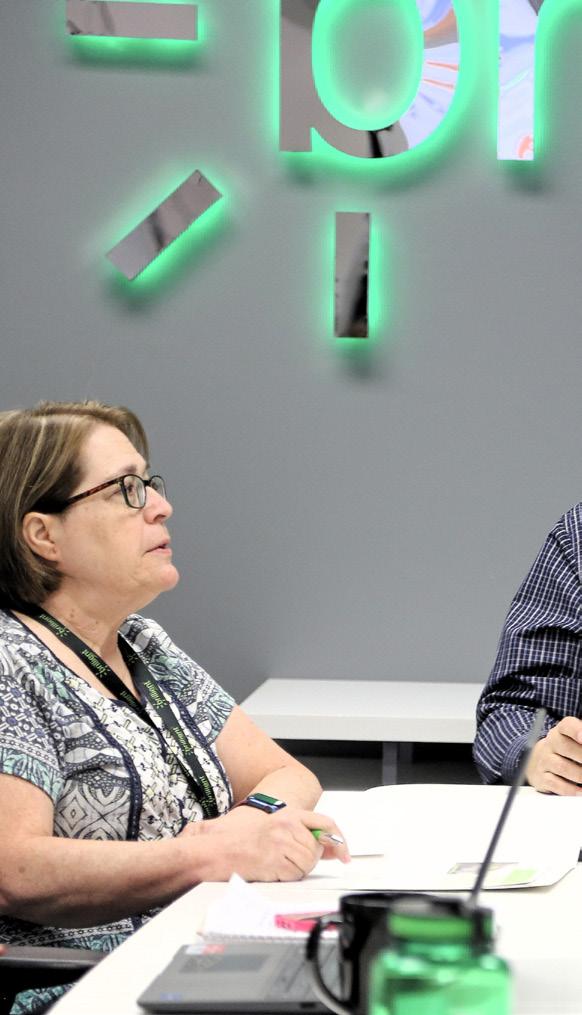
speak up, experiment, and take initiative. That culture of openness has led to some of the most impactful projects of his career. He’s worked across major federal health agencies, including the Department of Veterans Affairs, the Centers for Medicare and Medicaid Services (CMS), the Centers for Disease Control and Prevention (CDC), and the Office of the National Coordinator (ONC).
“I’m proud of the work we did modernizing systems for Medicare and Medicare Advantage,” Richard says. “These platforms support real people. You can feel the impact.” He also points to a partnership with the ONC, where we
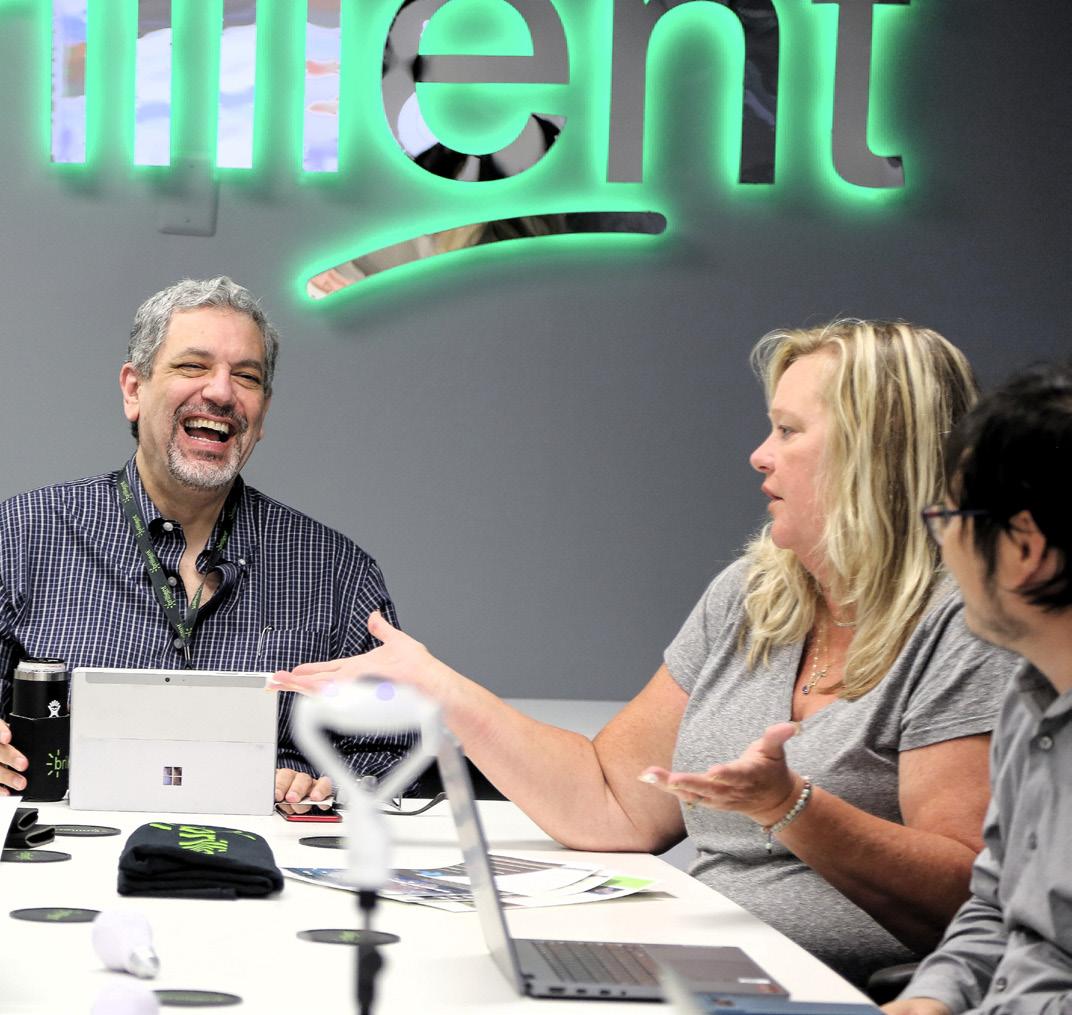
played a role in helping to create the software and standards for electronic health record interoperability. That work continues to shape how healthcare providers access and use patient data. And then there are projects that deal with global health crises—like Ebola tracking and HIV/AIDS prevention at the CDC. He adds, “We knew we were doing work that saved lives.”
Richard continues to support health agencies at Brillient, including the National Institutes of Health (NIH) and the Food and Drug
Administration (FDA), with a blend of research, technology, and strategic communications. It’s work that brings together Richard’s deep federal health background with the company’s longstanding expertise in AI and machine learning.
Another key lesson he’s picked up over the years is the value of healthy conflict. Richard has seen what happens when teams either argue too much or avoid disagreement altogether. Neither extreme helps. “The best
For Richard, leadership means more than just guiding projects—it’s about shaping the conditions that let good work happen


ideas come from teams that feel safe enough to disagree,” he explains. “You need people who can challenge assumptions, raise concerns, and push for better answers.”
At Brillient, Richard works to create that kind of space. One where respectful debate is encouraged, and curiosity is welcomed. He shares, “It’s not about winning arguments but about building trust. When people know they’ll be heard, they’re more likely to share their best ideas.” For Richard, leadership means more than just guiding projects— it’s about shaping the conditions that let good work happen. That means listening, empowering, and sometimes getting out of the way.
At Brillient, innovation is a part of the culture. Richard makes it a point to ensure his teams stay curious, connected, and open to new ideas. That means staying close to what’s happening across government and
academia, and bringing those insights into the work. “We’ve partnered with universities like George Mason to bring in fresh perspectives,” Richard explains. “We’ve hosted faculty talks and brought in Ph.D. interns to work with our engineers. It keeps us learning and growing.”
To support this mindset, Brillient launched ALICE Labs—an in-house innovation space where teams can explore, experiment, and challenge the status quo. It’s where ideas are tested before they become real-world solutions. “It’s a place where our teams can push boundaries. We want people to be learning all the time,” he says.
Richard’s belief in lifelong learning runs deep. Outside of work, he’s served on nonprofit boards focused on public health and education. That experience helped him see the value of diversity—not just in demographics, but in perspective. He states, “When you bring people together from different backgrounds, the quality of the solution improves. You get ideas that you wouldn’t have thought

Brillient has launched ALICE Labs—an in-house innovation space where teams can explore, experiment, and challenge the status quo
of on your own.” That mindset influences how Richard leads today. He knows that technology isn’t developed in a vacuum. The best solutions are informed by people’s lived experiences—how they work, what they need, and where the gaps really are.
Earlier in his career, Richard was a lecturer at Marymount University. He taught courses in system design, human factors, modeling and simulation, and software reliability. While he hasn’t been in the classroom recently, he still finds ways to stay engaged. Through his work as Industry Chair with the AI-inGovernment Council—a George Mason University initiative that brings together technologists from academia, government, and industry—he continues to participate in discussions that shape how AI is applied in service to the nation.
For Richard, good technology is about more than just functionality. It’s about trust. That’s why he emphasizes reliability—not only as a technical requirement but as a human one. “Reliability isn’t only technical—it’s about trust,” he explains. “When people count on a system, it has to work every time. Otherwise, they stop trusting it—and us.”
When asked to define his leadership philosophy, Richard keeps it simple. “Leadership means building sustainable, citizen- and worker-centered solutions through purposeful innovation, sound architecture, empowered teamwork, and a relentless focus on delivering real, lasting impact rather than chasing credit.” That clarity of purpose shows in the way he leads— putting people first, making space for new voices, and focusing on outcomes that matter.

Adam Lindsey is the Vice President of Operations at Groupon, a global leader in e-commerce specializing in vouchers and local experiences. Joining Groupon in 2011 as a Customer Service Agent, Adam has held various roles internationally and now leads the company’s global Operations teams. With a strong commitment to continuous improvement, transformation, and operational excellence, he remains dedicated to amplifying the voice of the customer across all aspects of the business.
Recently, in an exclusive interview with CXO Magazine, Adam shared insights on the role of technology in enhancing CX, the secret mantra behind his success, personal hobbies and interests, future plans, words of wisdom, and much more. The following excerpts are taken from the interview.


Adam Lindsey
VP, Groupon Operations | Cross-functional Team Leadership, Strategy, Groupon
Hi Adam. What drives your passion for customer experience and operations?
Operations is one of those fields you either love or you don’t , the best Ops folks are often those who’ve walked in the shoes of every role they now support. They are able to understand the customer experience 360 degrees; incorporating the customer, agent and business aspects into their work.
I’ve been in this space for nearly 20 years, starting my first role as a customer service agent the same week I turned 18. Two decades later, my commitment to improving, transforming, and streamlining teams, tools, processes, and policies remains as strong as ever.
CX is a multi-faceted skill requiring a wide range of knowledge and experience; tied with expert-level focus areas. Bring your team along for the ride, keep the mission clear in
everyone’s mind, the north star is critical. I have the privilege personally of working in my current company for almost 14 years, starting as a CS agent and now leading the post-purchase support teams, Customer Support, Merchant Support, Content Operations along with a host of other amazing teams such as GLD and Workforce Management. It’s been a journey of continuous growth, impact and evolution.
What do you love the most about your current role?
It always has been and always will be the people. CX, Operations and most roles in this area are filled with people from the most diverse backgrounds and experiences. There is strength in diversity, hence having such a wealth of expertise to collaborate with and work towards solutions, ensures that no two days are the same.
Technology enhances CX, but it’s only as effective as the processes behind it. AI must complement human insight, not replace it, ensuring a seamless customer journey from start to finish
What role do you think technology plays in enhancing CX?
Technology plays an increasingly critical role in enhancing customer experience, but it’s important to remember that it’s not a standalone solution. Today, with AI rapidly evolving, technology is more accessible and democratized than ever— allowing almost anyone to build or implement new tools. That accessibility brings enormous opportunity, but also a reminder: without deep understanding of the business, the customer journey, and the processes and policies behind the scenes, technology alone can fall short. Over a decade ago the buzz was around how chatbots would automate 80% of the workload, removing the role of agent in the CX space. After countless failed attempts to make this happen, it is since apparent that technology is only as good as the policies and processes that support it.
CX is after all the end to end journey of a customer, it begins way before the customer speaks with a human. Ensuring technology (and specifically AI) are consciously and intelligently embedded within an ecosystem is where the USP of CX comes into play.
How do you stay current with the latest trends and innovations in CX?
By speaking with as many people as possible, as often as possible, from as diverse backgrounds as possible. Echo chambers can be damaging, even keeping discussions within the business you work for can become an echo chamber. LinkedIn, events (remote and online), keeping in touch with former colleagues, talking through internal issues with external people, all ensures that you keep up to date with trends, successes and failures. In almost every instance, you are
not the first person to solve a problem; find others who have tread the same path already, it will save a lot of time and energy.
Congratulations on being recognized as one of the top 50 CX Leaders in 2025!
Our readers would love to know the secret mantra behind your success.
Thank you very much, it is an honour to be recognised! There is no secret, simply work hard, be responsive, own problems through to resolution, learn about as many topics as possible, especially those not within your direct remit. CX is universal and encompasses almost every aspect of a business; so learn all of those aspects. Make connections, build relationships and always be part of the solution.
What is your leadership philosophy and how do you keep team engaged and motivate them?
My main mantra is “everything can always be improved.” Just because a project is complete does not mean that the solution is perfect, it means we have improved and iterated on the prior version; and will improve again. Continuous improvement is key, it is rare to have spikes of improvement, also spikes from experience tend not to be healthy. What is desired is healthy, continuous and sustainable improvement. Progress should be consistent, aligned with long-term north star goals and course corrected frequently.
What has been your most careerdefining moment that you are proud of?
India is in many ways my second home, after living in Chennai for the entirety of 2013 and
Continuous improvement is key—progress should be sustainable, aligned with long-term goals, and course-corrected frequently. The best solutions evolve rather than arrive in sudden, dramatic spikes
visiting several times a year since. I’m proud of the work we did in 2023 to successfully expand and scale our global operations in Bangalore and Chennai, growing our capabilities whilst concurrently improving service levels, CSAT, MSAT, and other key metrics. Transformation can be hard, especially at this scale, but if done correctly, with the right people and the right strategy, ensures positive outcomes.
What are your passions outside of work?
I’m an avid reader, huge fan of music and also a marathon runner in training. I spend as much time as possible outdoors when I’m not working,
including frequent breaks in our campervan. Anything that takes me away from screens, whether it’s playing guitar, running, reading or exploring is what gives me energy whilst in work.
Where do you see yourself in the next 5 years?
The million dollar question. I initially joined Groupon expecting a short-term opportunity in Customer Service, but Fast-forward almost 14 years later, I’m still in my first business postgraduation, after living around the world and leading thousands of colleagues across multiple teams and organisations. I tend to look at things in smaller intervals, each year I ask myself the question “am I still learning, is there still a challenge” and as long as the answer is “yes” I will continue. The day the answer is “no” I’ll know it’s time to find my next mission.
What advice would you give to organizations looking to build more effective CX teams and strategies?
Build strength through diversity, the best strategies incorporate multiple viewpoints and perspectives. Not only the customer perspective, also internal user, Finance, Sales, Product, Engineering, the list goes on. The best strategies work when these perspectives are already baked in from the onset. And if not, following diversity, flexibility is key. Flexibility to pivot, flexibility to scale, rollback or even cancel an initiative altogether.
And finally, AI is simply one tool amongst many. AI is a great assistant, but in many areas a poor substitute for human insight, empathy, context and lived experience. Use AI as you would any other tool, appropriately and in context with the wider ecosystem.


Sophie Steinmeijer Chief Customer Officer,
CHIEF CUSTOMER OFFICER
Sophie Steinmeijer’s journey into customer leadership began with a deep curiosity about people. Even during her academic years, she was intrigued by how individuals make decisions and how organizations can play a meaningful role in shaping those experiences. “I’ve always been fascinated by customers and their behaviour,” she says. “That interest started early, even during my academic journey.”
Her early career took her into the world of research and analytics. It was a strong foundation, but something was missing. The numbers were insightful, but they lacked the human interaction Sophie craved. She soon
realized that her energy belonged in a more hands-on, customer-facing role—one where she could directly influence customer success. That realization brought her to TOPdesk.
From day one, Sophie was drawn to the company’s people-first culture. But what made her stay was the way teams worked with customers: empathetically, pragmatically, and with a real sense of partnership. As she puts it, “What kept me here is how authentically our teams collaborate with customers—practical in approach, yet deeply rooted in collective ownership.”
Working as a consultant within the company gave her a close-up view of life on the frontlines. That experience still shapes how she leads. Her

In services, TOPdesk consistently earns a Customer Satisfaction (CSAT) score of over 95% — a figure that reflects both the quality of the support and consultancy offered, and the dedication of the people delivering it
approach is rooted in empathy and realism, shaped by a clear understanding of what customers need in practice—not just in theory.
A defining moment in Sophie’s path to becoming Chief Customer Officer came when TOPdesk underwent an organizational restructure. Support, Consultancy, and Planning were brought together under one umbrella to create a unified customer domain. “It was the perfect match for my vision,” she explains. “Putting the customer at the centre of everything we do, not just in words, but structurally and operationally.”
Today, she leads a cross-functional team that spans Customer Success Management, Consultancy, Support, and Planning. Together, they support customers throughout their entire journey—from implementation to adoption and beyond. “Even the best software won’t deliver results if it’s not implemented well,” Sophie notes. “That’s where our domain comes in.”
The results speak for themselves. In services, TOPdesk consistently earns a Customer Satisfaction (CSAT) score of over 95% — a figure that reflects both the quality of the support and consultancy offered, and the dedication of the people delivering it.
For Sophie, the work is about more than metrics. It’s about enabling customers to work better, feel more in control, and enjoy what they do. “It’s always rewarding to hear customers say they enjoy their work more now that they can manage requests more effectively and work with greater ease,” she shares.
Behind the scenes, Sophie focuses on aligning strategy with execution—ensuring that services are not just efficient, but truly effective. She leads with clarity and care, helping her teams stay focused, remove roadblocks, and
consistently deliver high-impact outcomes. “I’m fortunate to work with a fantastic team of professionals who truly care about our customers—and about each other,” she says. “My role is to keep us all focused in the same direction and make sure our teams have what they need to succeed.”
At TOPdesk, the post-sales journey is a team effort—one that brings together multiple disciplines, each with a clear role in helping customers succeed. Support, Consultancy, Planning, and Customer Success Management (CSM) may operate in different functions, but they are united by a shared purpose: delivering real value to customers at every step.
Sophie believes this alignment is not just important—it’s essential. “Each discipline brings its own expertise—from deep product knowledge in Support to aligning product adoption with customer goals in CSM, and implementation know-how in Consultancy,” she explains. “But we’re most effective when we align our efforts and speak the same language to the customer.”
That alignment begins with clarity of purpose. For Sophie, it’s about more than just structure—it’s about culture. A strong, collaborative environment allows teams to trust each other, coordinate their strengths, and stay focused on a common goal. “Shared goals, mutual trust, and a customer-centric mindset across the board,” she says, are what make the balance work.
One initiative that stands out is the creation of TOPdesk’s internal AI tiger team. The idea came from something simple: listening to customers. Feedback revealed that many
users weren’t aware of the AI features already available in TOPdesk. That insight pointed to a clear opportunity.
Efficiency is a top priority for many of TOPdesk’s customers, and the AI tools already built into the platform could help them move faster and work smarter. But awareness was low. Sophie and her team responded quickly. They brought together colleagues from Marketing, Sales, Product, Consultancy, and Support to form a cross-functional task force focused on delivering quick, practical results.
“The goal was twofold,” Sophie says. “We wanted to show how AI can drive efficiency and improve service quality—and at the same time, we wanted to gather real-world use cases and customer needs to guide our product development.” The initiative paid off. Customers gained a better understanding of how to make the most of TOPdesk’s AI capabilities. Internally, it also helped teams break silos, collaborate faster, and build momentum around a common goal.
The company is also applying these same AI tools internally to improve its own support operations—which, fittingly, run on TOPdesk. While exploring ways to streamline internal workflows, Sophie remains mindful of maintaining service quality. “Efficiency should never come at the cost of quality,” she points out.
Sometimes, even long-standing customers aren’t aware of features that could dramatically improve their workflows. By proactively surfacing these capabilities, Sophie’s teams are helping customers work move closer to their long-term goals.
For Sophie, customer focus is a mindset that runs through everything TOPdesk does. Whether it’s

With work underway on a unified data layer, TOPdesk is aiming for a full 360° view of each customer— making timely, personalized support a reality across every touchpoint

in the Netherlands, Brazil, or anywhere else in the world, the commitment to staying close to the customer remains the same.
TOPdesk made a clear decision not to outsource its services, even when that could reduce costs. Instead, it keeps its support and consultancy local. “This allows us to offer high-quality service that is culturally relevant and truly helpful,” Sophie explains. “Our colleagues understand the local context because they are part of it.”
Across different geographies, the teams are trained to do more than just solve problems. They’re encouraged to think ahead, anticipate needs, and find ways to help customers reach their goals. This proactive approach makes a real difference—because customers don’t want a vendor, they want a partner.
To stay aligned internationally, TOPdesk brings together cross-functional and crosscountry teams on a regular basis. These meetings are spaces for sharing insights, aligning goals, and spreading what works. At the same time, there’s room for local adaptation. “It’s not about central control,” Sophie says. “It’s about shared purpose and strong collaboration.”
One key focus is improving visibility across the customer journey. By understanding what’s working—and what isn’t—at every stage, the company can provide more consistent and meaningful experiences worldwide. This balance between global cohesion and local flexibility is what enables every team to deliver on the company’s promise to its customers.
Creating a customer-centric culture isn’t something Sophie believes can be done through posters or internal campaigns. It has to be visible in actions, habits, and priorities. “It’s something we live every day,” she says. From

day one, new consultants are trained with the customer in mind. They’re taught how to guide implementations in a way that leaves the customer confident, capable, and ready to manage the system independently.
Importantly, this culture isn’t just shaped by leadership—it’s owned by everyone. Teams are encouraged to come up with their own ideas to improve the customer experience, and they’re supported from the concept stage all the way through execution. Hiring and onboarding
also reflect this mindset, with a focus on practical learning, strong peer support, and a shared commitment to helping others succeed.
“From how we design processes to how we communicate, the reflex question is always, ‘Does this help the customer succeed?’” Sophie says. When that question becomes second nature, she knows the culture is working.
Technology and data also play a central role in enhancing the customer experience. TOPdesk uses both across the full customer journey—
from onboarding to expansion. Predictive analytics are being developed to anticipate customer needs and catch potential issues early. For example, consultancy teams now use implementation data to better scope projects and shorten time-to-value.
Support operations have also become more efficient. Ticketing workflows are closely tied to the self-service portal and knowledge base, enabling quicker resolutions without compromising quality. AI-generated insights are starting to create even stronger feedback loops between the customer-facing teams and product development, helping the company focus on what truly matters to users.
With the introduction of Customer Success Management, the use of health scores and analytics has become more proactive. The team can now step in before problems arise. And with work underway on a unified data layer, TOPdesk is aiming for a full 360° view of each customer—making timely, personalized support a reality across every touchpoint.
Evolving with the Customer
TOPdesk’s core strength has always been in IT Service Management (ITSM). As organizations
gained more structure and visibility using the platform, many naturally began extending its use beyond IT. “We often see that once our IT customers gain better control over their own processes, the next logical step is to involve other internal departments,” Sophie explains. While Enterprise Service Management (ESM) is a growing area of application, ITSM continues to be the main focus — and the starting point for most customers.
That next step makes sense. Teams like HR, Facilities, and Finance all play a role in shared internal processes. Onboarding a new employee, for example, requires seamless coordination between multiple departments. When these teams use separate systems, things get messy. But with a platform like TOPdesk—designed to be flexible and collaborative—organizations can manage shared services without friction.
As customers began using the tool beyond IT, TOPdesk adjusted its approach to match. The engagement strategy shifted to include more stakeholders from the start. Consultants now support collaboration across departments. And the company shares best practices for working across organizational silos.
Customer-led growth is deeply embedded in how TOPdesk operates. Teams monitor key metrics like Net Retention Rate (NRR), Customer Satisfaction (CSAT), and Net Promoter Score (NPS)
Despite the broader focus, the foundation remains the same: helping teams collaborate better, be more transparent, and deliver reliable service. “As our customers grow into ESM, we grow with them,” Sophie says. “And our engagement strategy ensures we continue to meet their evolving needs at every step.”
Feedback plays a big role in this growth. For Sophie and her teams, listening to customers isn’t a nice-to-have—it’s essential. It guides both product innovation and service delivery. “Feedback gives us a direct view into what the market needs,” she explains. “It helps us stay aligned with the real challenges our customers face.”
That feedback comes from many places: support tickets, satisfaction surveys, and direct engagement through customer communities and advisory boards. The TOPdesk team analyzes recurring themes—whether it’s a bug, a usability issue, or an opportunity to enhance service delivery. Recently, the company earned a TrustRadius Top Rated Award — a recognition Sophie sees as a reflection of mutual trust. “We’re lucky to have a highly engaged customer base,” she says. TOPdesk is proud to have received this award for the ninth year in a row, based on more
than 230 verified reviews and a trScore of 8.5 out of 10. The recognition highlights TOPdesk as a leading solution in IT Service Management, and a reliable partner in Facility Management and IT Asset Management.
But it’s not enough to collect feedback. Acting on it is what makes a difference. TOPdesk recently upgraded its feedback tools so customers can easily submit ideas—and track how they’re being handled. This added transparency encourages real co-creation. The company also pulls in informal insights from teams across departments, building a more complete picture of what users want and need.
Customer-led growth is deeply embedded in how TOPdesk operates. Teams monitor key metrics like Net Retention Rate (NRR), Customer Satisfaction (CSAT), and Net Promoter Score (NPS). But those numbers aren’t tracked in isolation—they’re shared across teams, creating joint accountability for the entire customer experience. “We know that the more customers interact with our teams, the more satisfied they tend to be,” Sophie notes. So the focus is always on delivering that experience consistently—no matter who the customer is engaging with.
From hospitals to universities to local governments, organizations rely on TOPdesk to support their internal service processes — each in their own way
TOPdesk excels in key service areas like onboarding speed, implementation satisfaction, and support resolution times — all of which contribute to a consistent, high-quality experience for customers. Meanwhile, the teams are also working on gaining better insight into product adoption, so they can take a more proactive role in helping customers get the most out of the platform. “In the end,” Sophie says, “you want to make sure we find the cure for the
problem the customer is trying to resolve — not just alleviate the symptoms.”
One of TOPdesk’s key strengths is its ability to scale across industries without losing focus. The platform is built on ITIL principles, which continue to serve as a strong foundation for service excellence. Its flexible setup allows organizations in sectors like healthcare,
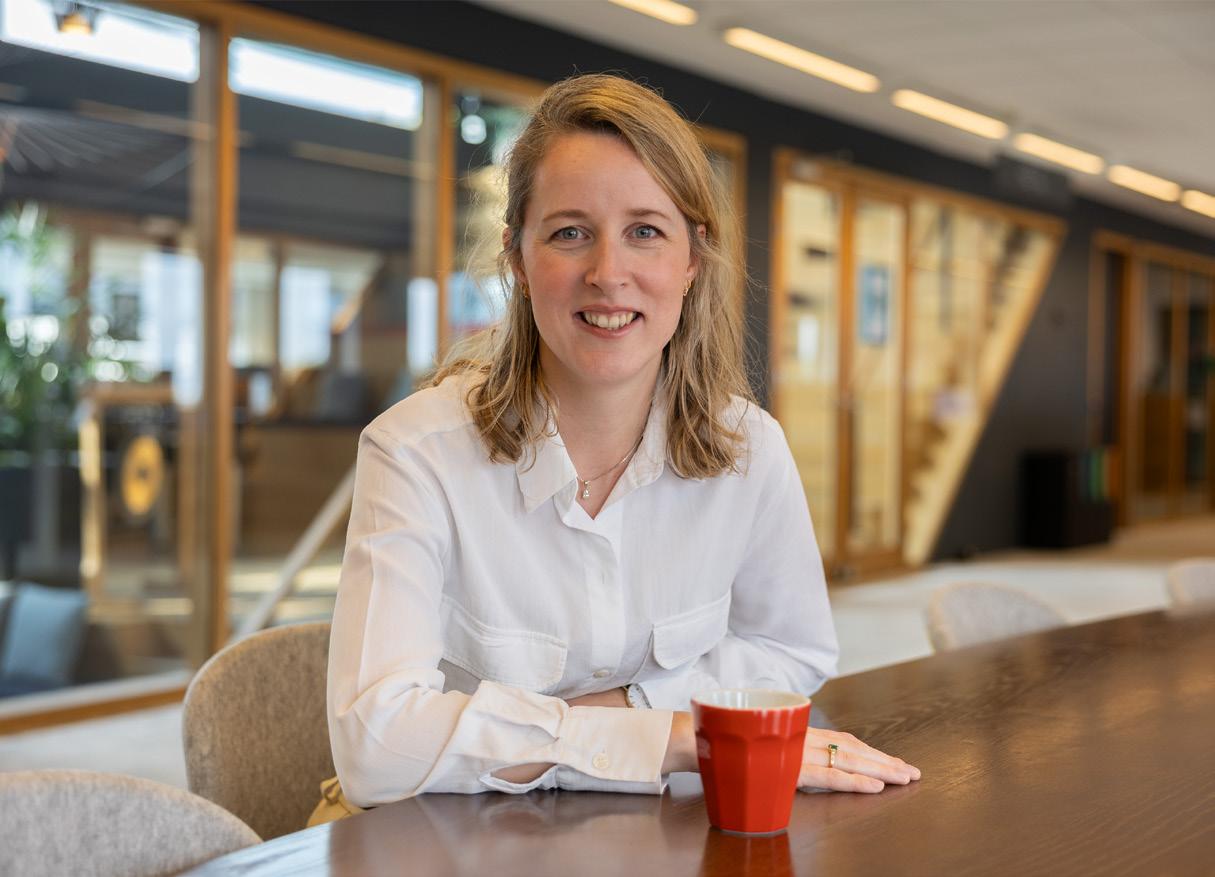
education, and government to tailor the system to their specific workflows while staying aligned with proven service management practices.
There’s no single formula. Different industries have different priorities. A hospital might focus on compliance and incident management, while a university needs strong asset tracking and student-facing service portals. That’s why TOPdesk never takes a onesize-fits-all approach. Instead, the company adapts onboarding and support to match each customer’s environment. “Scalability across industries is one of our core strengths,” says Sophie. “We make sure our platform fits each organization’s context from day one.”
TOPdesk consultants play a key role here. Many have experience working across sectors and bring that insight into every project. When useful, they share best practices from other industries — always making sure the advice fits the customer’s goals.
The platform’s modular setup allows it to grow with customers over time. As needs evolve, organizations can adjust or expand their use of the tool without disruption. Paired with a strong focus on customer success, this adaptability ensures that TOPdesk stays relevant — no matter the scale, industry, or phase of digital maturity.
Sophie’s leadership approach is grounded in trust, empowerment, and customer-focused growth. For her, leadership is about creating the right environment — one where people have the tools and freedom to do their best work. “The real power of customer focus lies with
Sophie believes that when you help customers succeed — when you support their true goals — growth follows naturally for both sides

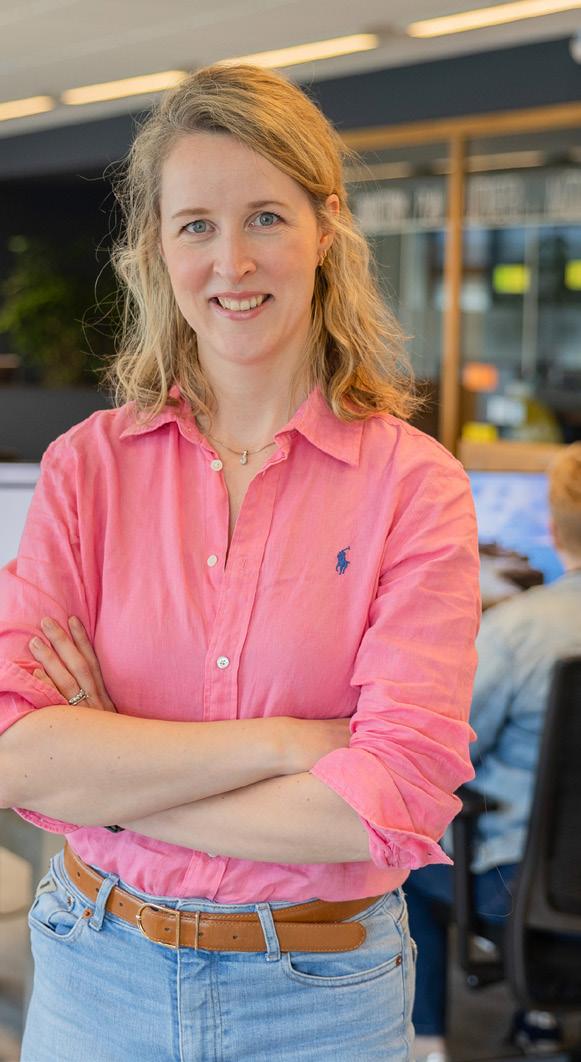
the colleagues who interact with our customers every day,” she says. “My role is to remove barriers and help them succeed.” A naturally positive outlook shapes Sophie’s way of leading. She sees challenges as opportunities to learn and grow, and encourages her teams to do the same. This mindset fosters a culture where resilience and creativity thrive.
TOPdesk’s approach to growth is grounded in real relationships and active listening. A strong example of this is how the company handled feedback on its mail import feature. “Our own Support team uses the platform, too,” Sophie shares. “When we saw over 1,000 tickets related to the mail import feature, we knew something needed to change.” The Product team responded with a redesigned interface, making the feature easier to use — and reducing support questions by 40%.
The Product team responded with a redesigned mail import interface, making it easier for users to get value from the feature. As a result, support questions on that topic dropped by 40%. For Sophie, this is what customerdriven growth looks like in action: seeing a need, solving the right problem, and improving the experience for everyone.
What Sophie is most proud of isn’t a single milestone — it’s the alignment she’s helped build across departments. By uniting support, consultancy, CSM, and planning teams under one shared vision, TOPdesk is moving from reactive service to proactive value delivery.
Customer feedback continues to shape product development at TOPdesk, contributing to strong outcomes across satisfaction and
By uniting support, consultancy, CSM, and planning teams under one shared vision, TOPdesk is moving from reactive service to proactive value delivery
retention. “It’s a team win,” Sophie says. This approach is still evolving. A key next step is to carry this alignment through the entire postsales journey. Introducing the Customer Success Management (CSM) function is a big part of that. Until recently, the role didn’t exist at TOPdesk. Now, it’s a central piece in ensuring customers receive value at every stage of their journey. What drives Sophie is seeing the ripple effects of positive outcomes — when solving a tough issue or supporting a complex change creates real progress for a customer. “That’s the impact that motivates me,” she says. “It reminds me why we do this.”
She’s also committed to continuous learning. Sophie regularly engages with other SaaS leaders, reads, attends forums, and benchmarks ideas. But she doesn’t stop there — she learns just as much from her own team. “Being surrounded by people who are always experimenting keeps me growing,” she says.
For her, creating space for feedback and experimentation is key to authentic leadership. It helps the organization stay flexible, curious, and ready to meet new challenges. “Continuous learning isn’t optional in this space,” she adds. “It’s the only way to lead with confidence and stay ahead.”


Banu Cinar is an accomplished customer experience leader currently serving as the Head of CX Design at Jaguar Land Rover. With extensive experience in the luxury automotive sector, Banu has previously held key roles such as Senior CX Strategic Design Consultant at E.ON and Global Head of Customer Experience at Experian. She excels in developing enterprise CX strategies and driving digital transformation projects. Banu holds a Master’s degree in Customer Excellence Management and various certifications in business analysis, project management, and digital marketing. Her expertise lies in customer journey optimization, governance, and innovation, making her a prominent figure in the industry.
Recently, in an exclusive interview with CXO Magazine, Banu shared insights on the role of technology in enhancing CX, her secret to striking a work-life balance, future plans, words of wisdom, and much more. The following excerpts are taken from the interview.

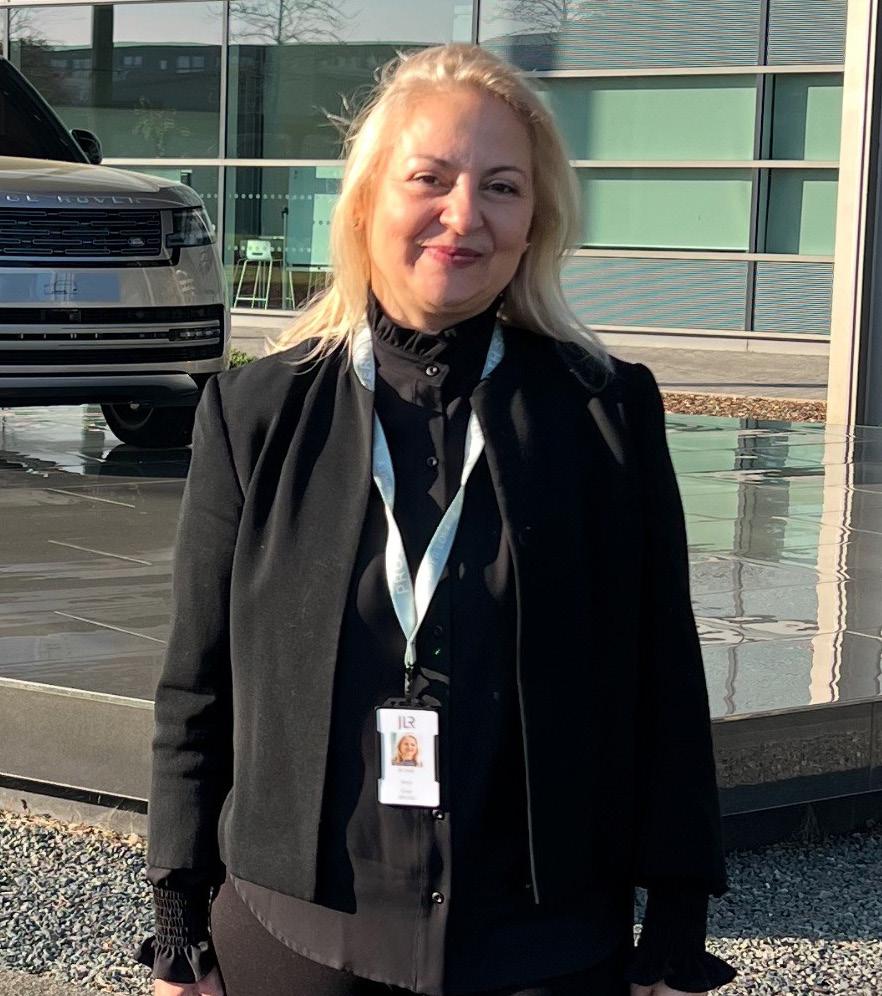
Head of CX Design, JLR
Hi Banu. What inspired you to pursue a career in customer experience management?
My inspiration to pursue a career in customer experience management stemmed from my fascination with the Voice of Customer and its potential to create unparalleled experiences. Growing up, I was captivated by the influence and innovation of successful brands. I realized that beyond the engineering or manufacturing marvels, the true essence of luxury and success lies in the exceptional service and personalized experiences offered to customers. This realization drove me to focus on customer experience management, where I could blend my passion for voice of customers with my commitment to delivering outstanding customer experiences.
What do you love the most about your current role?
What I love most about my current role is the ability to shape and enhance the customer journey for our high-end clientele. Working in the luxury automotive sector allows me to create bespoke experiences that exceed expectations and build lasting relationships with our customers. The challenge of continuously innovating and refining our approach to customer service keeps me motivated and excited every day. Seeing the joy and satisfaction on our customers' faces when they interact with our brand is incredibly rewarding.
What's your perspective on the role of technology in enhancing customer experience?
Technology is a game-changer in enhancing customer experience, especially in the luxury automotive sector. Advanced technologies such as AI, augmented reality, and data analytics
enable us to offer personalized and seamless interactions. For instance, AI-driven insights help us understand customer preferences and anticipate their needs, while augmented reality can provide immersive virtual tours of our vehicles. Technology also streamlines processes, ensuring that our customers receive prompt and efficient service, which is crucial for maintaining the high standards expected in the luxury market.
How do you foster a customer-centric culture within an organization?
Fostering a customer-centric culture within an organization starts with a clear vision and commitment from leadership. I prioritize open communication and ensure that every team member understands the importance of customer experience. Regular training sessions and workshops help reinforce customer-centric values and practices. Additionally, I encourage feedback from both customers and employees, using it to drive continuous improvement. Recognizing and rewarding employees who excel in customer service also helps to embed a customer-first mindset throughout the organization.
Do you notice a lack of women in CX? If so, why do you think that’s the case?
Yes, there is a noticeable lack of women in CX, particularly in leadership roles within the luxury automotive sector. This disparity can be attributed to historical gender biases and the perception of the automotive industry as male-dominated. Additionally, there may be fewer opportunities for women to advance in this field due to existing workplace dynamics. Addressing this issue requires proactive efforts to promote diversity and inclusion, such as
Technology streamlines CX, but true luxury is in the details— understanding customer needs, anticipating their expectations, and delivering an experience that feels effortless yet deeply personal
mentorship programs, equitable hiring practices, and creating a supportive environment for women to thrive.
Looking back, which women in your life have had the most influence on your career?
The women who have had the most influence on my career are my mother and my first mentor in the customer experience discipline. My mother instilled in me the values of perseverance, empathy, and hard work, which are essential in customer experience management. My mentor, a pioneering woman in the customer experience discipline, provided invaluable guidance and support, helping me navigate the complexities of the different industries and encouraging me to pursue my ambitions with confidence.
What does the term "authentic leadership" mean to you?
Authentic leadership means leading with integrity, transparency, and a genuine commitment to the well-being of both customers and employees. It involves being true to one's values, admitting mistakes, and continuously striving to improve. Authentic leaders inspire trust and loyalty by being approachable, empathetic, and consistent in their actions and decisions. In the luxury automotive sector, authentic leadership is crucial for building strong relationships and maintaining the high standards expected by our clientele.
What is your secret behind striking a work-life balance?
Striking a work-life balance involves setting clear boundaries, prioritizing tasks, and making time for self-care. I schedule regular breaks
Authentic leadership is about transparency and trust— empowering teams to innovate, supporting their growth, and ensuring every decision aligns with a long-term vision of excellence
throughout the day, ensure I have time for hobbies and family, and practice mindfulness to stay grounded. It’s also important to delegate tasks and trust your team, allowing you to focus on what truly matters both at work and in your personal life. In the luxury automotive sector, where demands can be high, maintaining this balance is essential for sustained productivity and well-being.
Where do you see yourself in 5 years from now?
In five years, I see myself continuing in a senior leadership role, driving strategic initiatives to enhance customer experience on a larger scale within the luxury automotive sector. I hope to continue advocating for customer-centric practices and leveraging technology to create innovative solutions. Additionally, I aim to mentor the next generation of CX professionals,
particularly women, to help them achieve their career goals and contribute to a more diverse and inclusive industry.
What advice would you give to someone looking to break into the field of AIdriven customer experience?
My advice would be to develop a strong foundation in both customer experience principles and AI technology. Stay curious and continuously learn about the latest trends and tools in the industry. Gain practical experience through internships or projects, and don’t be afraid to experiment with new ideas. Networking with professionals in the field and seeking mentorship can also provide valuable insights and opportunities. In the luxury automotive sector, understanding the unique needs and expectations of high-end customers is crucial for success in AI-driven customer experience.






